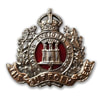2016 Friends News
2016 was again, an amazing year for the Friends. We ran not one, but two, dedicated Battlefield Tours - within days of one another. We made new links with our Belgian and Dutch Friends in Hamont and Weert, and have started planning another tour for the future. We had many sad losses, most notibly, Brigadier Bill Deller; an early Friends member and a great champion of the Friends, but our website proves ever popular and our ongoing mini-blog on the Great War service of the Suffolk Regiment now has many hundreds of followers. Read our year of news below to see what was going on.
The Loss of Friends Mac Read and Richard Scott
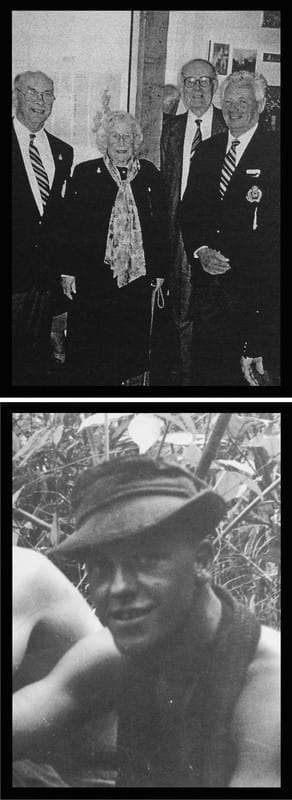
We have a rather sad note to end a most sucessful year for the friends, with the news of two more Friends members, and former Suffolk Regiment soldiers passing away.
Firstly we heard of the loss of Mac Read; Beccles Branch OCA Chairman and early Friends member, who served in Cyprus with 1/Suffolk between 1957 and 1959, then today, came the news that staunch Friends member Richard Scott, who had served with 1 Suffolk in Malaya between 1949 and 1952, has also passed away.
Mac Read who served with HQ Company of 1 Suffolk in Cyprus between 1957 and 1958, was an original member of the Beccles Branch of the Old Comrades Association. He joined them at their creation in July 1986, whilst he was still working.
At that time meetings were held in the King’s Head pub, before they moved to the Caxton Club in 1988. At this time, with the assistance of the Branch President, Major W.D. Curnock, Mac, who was then not on the Branch Committee, organised for the branch to have a new Vice-President; Mrs Lois Moriarty, widow of the late Captain R.E.B. Moriarty, who lived at nearby Wangford, and who had been a great supporter of the Branch from its very creation, even though her late husband had died in 1969.
In June 1996, Mac took over the chairmanship of the branch, after many stalwart members had stepped down due to illness. Though he was seen as a ‘youngster’ having served just prior to amalgamation, he was much welcomed and under his leadership, the Branch continued to flourish.
The annual displays of Regimental memorabilia in the town's library and the town’s shop windows, together with the Branch’s annual tent at the annual carnival, kept up a Suffolk Regiment presence in the district. One of the first things that Mac did as Chairman was to approach the notable war correspondent and author, Martin Bell, to see if he would like to be an Honorary Vice-President. Bell's father was the noted Suffolk author, Adrian Bell, and Martin had served alongside Mac in Cyprus. He accepted and is to this day, President of the branch.
Mac had been in failing health for some time and there had not been any Branch events for some time. He was however, always cheerful and bore a great smile whenever he was seen at Regimental functions. We extend to his family our most sincerest sympathies at this time.
Following this saddening news, an email came today informing us of the death of Friends member Richard Scott in Canada.
No. 22264495, Richard was a professional soldier joining 1 Suffolk in Greece in 1949. He went to Malaya and was engaged on early patrols in Kuala Kubu Bahru, when the Battalion were still acclimatising themselves to the jungle and were then under the command of the 2nd Battalion, Scots Guards. It was during this period that Richard narrowly avoided capturing the gang responsible for the death of the British High Commissioner for Malaya, Sir Henry Gurney. The gang responsible for the ambush of his motor car, made off through the jungle in an area where Richard was patrolling with 12 Platoon, D Company of 1/Suffolk.
Not much is known of Richards later life, except that he had been living in Canada for many years, and had been discovered by the late Ray Burdette in his internet trawling to find new members for the Hemel Hempstead Branch of the OCA in the late 1990s. Richard quite often made the journey from Canada to attend Minden Day at Bury St. Edmunds. The last occasion when he attended was in 2006, was truly a global Suffolk Regiment tour-de-force. Richard came from Canada, Boz Bostock from South Africa, Jack Kefford from Australia and Spud Taylor from Thailand. We extend to Richard’s family our most sincerest sympathies at this time and especially to his widow, Janice.
Posted: 31/12/2016
Above top: Mac Read right, with Branch Vice President, Lois Moriarty, at the openining of an Exhibition in Beccles Museum in 2004. Bottom, Richard Scott on a D Company patrol in Malaya, 1949.
Firstly we heard of the loss of Mac Read; Beccles Branch OCA Chairman and early Friends member, who served in Cyprus with 1/Suffolk between 1957 and 1959, then today, came the news that staunch Friends member Richard Scott, who had served with 1 Suffolk in Malaya between 1949 and 1952, has also passed away.
Mac Read who served with HQ Company of 1 Suffolk in Cyprus between 1957 and 1958, was an original member of the Beccles Branch of the Old Comrades Association. He joined them at their creation in July 1986, whilst he was still working.
At that time meetings were held in the King’s Head pub, before they moved to the Caxton Club in 1988. At this time, with the assistance of the Branch President, Major W.D. Curnock, Mac, who was then not on the Branch Committee, organised for the branch to have a new Vice-President; Mrs Lois Moriarty, widow of the late Captain R.E.B. Moriarty, who lived at nearby Wangford, and who had been a great supporter of the Branch from its very creation, even though her late husband had died in 1969.
In June 1996, Mac took over the chairmanship of the branch, after many stalwart members had stepped down due to illness. Though he was seen as a ‘youngster’ having served just prior to amalgamation, he was much welcomed and under his leadership, the Branch continued to flourish.
The annual displays of Regimental memorabilia in the town's library and the town’s shop windows, together with the Branch’s annual tent at the annual carnival, kept up a Suffolk Regiment presence in the district. One of the first things that Mac did as Chairman was to approach the notable war correspondent and author, Martin Bell, to see if he would like to be an Honorary Vice-President. Bell's father was the noted Suffolk author, Adrian Bell, and Martin had served alongside Mac in Cyprus. He accepted and is to this day, President of the branch.
Mac had been in failing health for some time and there had not been any Branch events for some time. He was however, always cheerful and bore a great smile whenever he was seen at Regimental functions. We extend to his family our most sincerest sympathies at this time.
Following this saddening news, an email came today informing us of the death of Friends member Richard Scott in Canada.
No. 22264495, Richard was a professional soldier joining 1 Suffolk in Greece in 1949. He went to Malaya and was engaged on early patrols in Kuala Kubu Bahru, when the Battalion were still acclimatising themselves to the jungle and were then under the command of the 2nd Battalion, Scots Guards. It was during this period that Richard narrowly avoided capturing the gang responsible for the death of the British High Commissioner for Malaya, Sir Henry Gurney. The gang responsible for the ambush of his motor car, made off through the jungle in an area where Richard was patrolling with 12 Platoon, D Company of 1/Suffolk.
Not much is known of Richards later life, except that he had been living in Canada for many years, and had been discovered by the late Ray Burdette in his internet trawling to find new members for the Hemel Hempstead Branch of the OCA in the late 1990s. Richard quite often made the journey from Canada to attend Minden Day at Bury St. Edmunds. The last occasion when he attended was in 2006, was truly a global Suffolk Regiment tour-de-force. Richard came from Canada, Boz Bostock from South Africa, Jack Kefford from Australia and Spud Taylor from Thailand. We extend to Richard’s family our most sincerest sympathies at this time and especially to his widow, Janice.
Posted: 31/12/2016
Above top: Mac Read right, with Branch Vice President, Lois Moriarty, at the openining of an Exhibition in Beccles Museum in 2004. Bottom, Richard Scott on a D Company patrol in Malaya, 1949.
Merry Christmas!
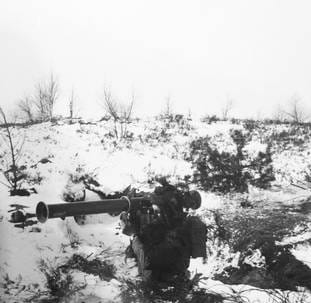
Wishing all Friends a very merry, red and yellow, Suffolk Regiment Christmas!
Spare a thought today for all those men of the Suffolk Regiment who were away on Active Service during the Regiment's existence and who could not spend Christmas with their families. Spare a thought too for the Regiment's sucessors; the Royal Anglian Regiment who today are today serving away from their families and friends.
Posted: 25/12/2016
Spare a thought today for all those men of the Suffolk Regiment who were away on Active Service during the Regiment's existence and who could not spend Christmas with their families. Spare a thought too for the Regiment's sucessors; the Royal Anglian Regiment who today are today serving away from their families and friends.
Posted: 25/12/2016
Front Page News...In Leiston!
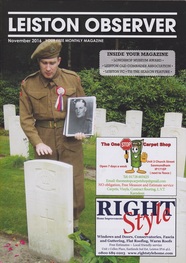
The Suffolk Regiment is back in teh public eye one more. Recently we received a message from Friend Kelvin Dakin to say that there was an article in the November edition of "Legion" Magazine, featuring the Chairman of the Baldock and Disctrict Branch, RBL, Peter Cherry, a 1/Suffolk veyerans who served in Cyprus, 1958-59.
Then a few days later, more news came from a Friend in Leiston to say that we had made the front cover of the "Leiston Observer" - the town's free monthly magazine for its residents. The front cover features quite coincendentally, Mark at the grave of Norman Jepps, a young soldier from Northamptonshire who was killed on 25th November 1944, whilst serving with C Company at Geijsteren. The excellent article within, was written by 1/Suffolk veteran, Jim Taylor who accompanied us on the tour.
It's great to see the cap badge out in force again, especially during this month of remembrance, proff that the Old Dozen is definately not forgotten!
Posted: 25/11/2016
Then a few days later, more news came from a Friend in Leiston to say that we had made the front cover of the "Leiston Observer" - the town's free monthly magazine for its residents. The front cover features quite coincendentally, Mark at the grave of Norman Jepps, a young soldier from Northamptonshire who was killed on 25th November 1944, whilst serving with C Company at Geijsteren. The excellent article within, was written by 1/Suffolk veteran, Jim Taylor who accompanied us on the tour.
It's great to see the cap badge out in force again, especially during this month of remembrance, proff that the Old Dozen is definately not forgotten!
Posted: 25/11/2016
11th Suffolk King's Colour - An Update
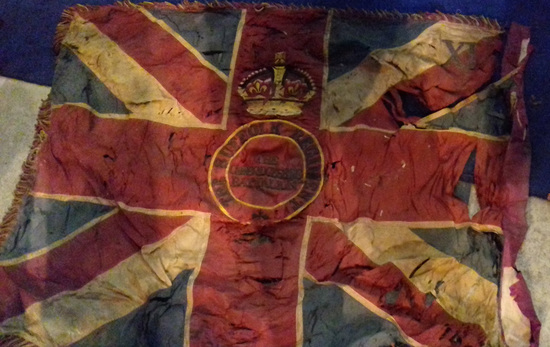
Via Friend of the Friends, Phil Curme, comes the first image of the frail 11th (Service) Battalion Colour.
Though the central section is still intact, the silk sleeve which holds the Colour to the pole, has disintegrated. What is curious is that unlike its other contemporaries that hang in the Regimental Chapel in Bury St. Edmunds, is that it appears to have never been netted. The frail silk colours were manufactured quickly at the end of the First World War for presentation to all Infantry, Dismounted Infantry, Graduated and War Raised Battalions that furnished troops for service overseas.
The sole surviving token of a grateful nation to a Battalion that served with distinction on the Western Front, it should be conserved at all costs. We'll post more news once we receive it.
Posted: 15/11/2016
Though the central section is still intact, the silk sleeve which holds the Colour to the pole, has disintegrated. What is curious is that unlike its other contemporaries that hang in the Regimental Chapel in Bury St. Edmunds, is that it appears to have never been netted. The frail silk colours were manufactured quickly at the end of the First World War for presentation to all Infantry, Dismounted Infantry, Graduated and War Raised Battalions that furnished troops for service overseas.
The sole surviving token of a grateful nation to a Battalion that served with distinction on the Western Front, it should be conserved at all costs. We'll post more news once we receive it.
Posted: 15/11/2016
11th Suffolk King's Colour - A Sad Occurrence
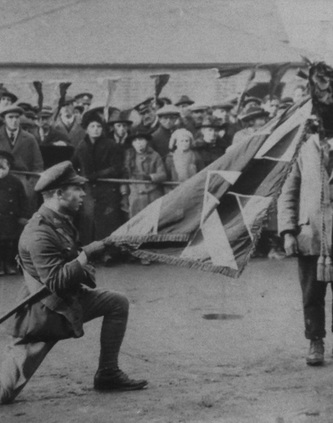
At the Cenotaph in Whitehall and at War memorial across the country, the Nation has paused today to remember its war dead.
Though today, the surviving ranks of the Suffolk Regiment are getting thinner at an alarming rate, it brings us much comfort to see so much renewed interest in the Regiment during this, especially during the ongoing centenary of the Great War.
Today, whilst we were attending the Service of Remembrance in Ipswich, we received news from our Friends in Cambridgeshire, of the sad fate that has befallen the Colour of the 11th (Service) Battalion, The Suffolk Regiment (Cambs).
The Colour, which has remained on its original pole since 1919, has hung outside the Cambridgeshire Regiment Chapel since 1923. Although it was netted in nylon in the 1960s, the ravages of time have meant that the frail silk had torn under the strain, resulting in the Church Wardens arriving one morning to find it having dropped from its pole onto the floor.
However, it has been carefully retrieved and is being stored in a safe and dry location where the Trustees of the Cambridgeshire Regiment collection will decide upon a suitable course of preservation. We'll keep you posted.
Posted: 13/11/2016
Though today, the surviving ranks of the Suffolk Regiment are getting thinner at an alarming rate, it brings us much comfort to see so much renewed interest in the Regiment during this, especially during the ongoing centenary of the Great War.
Today, whilst we were attending the Service of Remembrance in Ipswich, we received news from our Friends in Cambridgeshire, of the sad fate that has befallen the Colour of the 11th (Service) Battalion, The Suffolk Regiment (Cambs).
The Colour, which has remained on its original pole since 1919, has hung outside the Cambridgeshire Regiment Chapel since 1923. Although it was netted in nylon in the 1960s, the ravages of time have meant that the frail silk had torn under the strain, resulting in the Church Wardens arriving one morning to find it having dropped from its pole onto the floor.
However, it has been carefully retrieved and is being stored in a safe and dry location where the Trustees of the Cambridgeshire Regiment collection will decide upon a suitable course of preservation. We'll keep you posted.
Posted: 13/11/2016
Remember
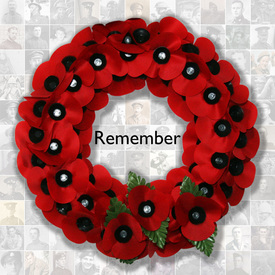
As the Nation pauses to remember the dead of two World Wars and other conflicts since, spare a thought today for all those men of The Suffolk Regiment, who since it's formation in 1685, have in many lands, given their lives for their country.
Spare a thought perhaps today for the three men of the Regiment killed 100 years ago today. Private Ernest Brunning of 7th Suffolk, Private Henry Connor of 2nd Suffolk, and Private G. Preston of 8th Suffolk, attached to the 53rd trench Mortar Battery.
We who follow in your footsteps, will remember you.
Posted: 11/11/2016
Spare a thought perhaps today for the three men of the Regiment killed 100 years ago today. Private Ernest Brunning of 7th Suffolk, Private Henry Connor of 2nd Suffolk, and Private G. Preston of 8th Suffolk, attached to the 53rd trench Mortar Battery.
We who follow in your footsteps, will remember you.
Posted: 11/11/2016
The Cadet Forces
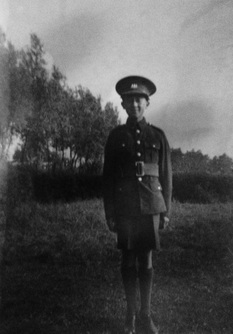
Recently we obtained this photograph of a very young member of the Cambridgeshire Regiment. As the subject does not appear to be wearing any form of insignia that marks him out as a young drummer boy, we believe he may be a member of the county's Army Cadet Force.
The Cadet Forces were as old as the Regiment's themselves, tracing their lineage back to 1850s when once again with the threat of a French Invasion, units of volunteers were formed, some of which were comprised from teenagers, serving alongside their fathers as message runners ad ammunition carriers. This young Cambs wears the Great War pattern of tunic and webbing waist belt. His khaki shorts, long sock and shoes typify him as a member of a school cadet unit. We are guessing from the style of dress, that the photograph dates from the 1930s.
The Cadets wore their original Suffolk and Cambridgeshire cap badges long after the amalgamation of the regular Battalion's and the merger of the Territorial ones. It was only with the creation of the new larger Royal Anglian Regiment in 1964 that all units were re-badges with that to the new affiliated Regiment.
We've long wanted to tell the story of the county's Cadet Forces, some of whom in the 1960s, were extras in a little known British film classic, shot at Leiston and at Southwold. If you have any photographs or information them, please get in touch with us.
Posted: 06/11/2016
The Cadet Forces were as old as the Regiment's themselves, tracing their lineage back to 1850s when once again with the threat of a French Invasion, units of volunteers were formed, some of which were comprised from teenagers, serving alongside their fathers as message runners ad ammunition carriers. This young Cambs wears the Great War pattern of tunic and webbing waist belt. His khaki shorts, long sock and shoes typify him as a member of a school cadet unit. We are guessing from the style of dress, that the photograph dates from the 1930s.
The Cadets wore their original Suffolk and Cambridgeshire cap badges long after the amalgamation of the regular Battalion's and the merger of the Territorial ones. It was only with the creation of the new larger Royal Anglian Regiment in 1964 that all units were re-badges with that to the new affiliated Regiment.
We've long wanted to tell the story of the county's Cadet Forces, some of whom in the 1960s, were extras in a little known British film classic, shot at Leiston and at Southwold. If you have any photographs or information them, please get in touch with us.
Posted: 06/11/2016
Pupils Plant New Daffodils At The Keep
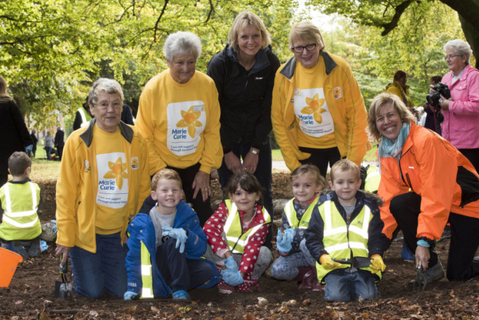
We were a bit late here in reporting the splendid news that on 21st October, pupils from the Sexton and Manor schools in Bury St. Edmunds, along with a number of volunteers, planted a new batch of daffodils in the parklands at the former depot of The Suffolk Regiment; Gibraltar Barracks.
This act, which is part of the "Bury in Bloom" campaign, will see new bulbs joining those already planted here over many years ago by members of The Suffolk Regiment. Some of the existing daffodils that flower every Easter, are over 100 years old, but many more were planted in the 1940s and 1950s by the then Depot Commander, Major J.C. Eley.
Eley, who was a keen gardener, ensured that the Depot grounds were well kept and that the numerous plants and shrubs that had been brought back from campaigns aboard during the 20th century, were all well maintained.
Were chuffed that the borough of Bury St. Edmunds cares enough to keep this important piece of parkland alive in the heart of the town, where yearly, it will become awash in yellow - the colour of the facings of the uniforms of the Regiment that once lived within its walls.
Posted: 24/10/2016
Photograph courtesy of the Bury Free Press
This act, which is part of the "Bury in Bloom" campaign, will see new bulbs joining those already planted here over many years ago by members of The Suffolk Regiment. Some of the existing daffodils that flower every Easter, are over 100 years old, but many more were planted in the 1940s and 1950s by the then Depot Commander, Major J.C. Eley.
Eley, who was a keen gardener, ensured that the Depot grounds were well kept and that the numerous plants and shrubs that had been brought back from campaigns aboard during the 20th century, were all well maintained.
Were chuffed that the borough of Bury St. Edmunds cares enough to keep this important piece of parkland alive in the heart of the town, where yearly, it will become awash in yellow - the colour of the facings of the uniforms of the Regiment that once lived within its walls.
Posted: 24/10/2016
Photograph courtesy of the Bury Free Press
The Colonel's Copy
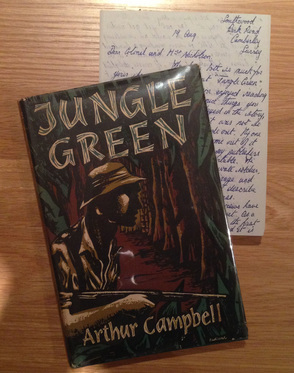
Most of you will be familiar with the fictionalised account of the 1st battalions actions in Malaya written by then Major, Arthur Campbell, entitled "Jungle Green."
Campbell, served with 1 Suffolk in Malaya from 1949 until late 1951, having joined the Battalion in Greece in 1948 being transferred from the 2nd Battalion in India, that was then being placed in "Susupended Animation."
Recently a first edition of his book has surfaced in a London Bookshop that was given to Colonel W.N. Nicholson, CMG, DSO, Colonel of the Suffolk Regiment from 1939 until 1947, by Arthur Campbell.
Campbell, a much respected figure in the post war years of the Regiment, writes in the letter that was found tucked into the book that, it was selling over 200 copies a day, and was shortly to be serialised by the BBC. He also stressed to the Colonel that "the real hero, of course, is the private soldier."
Campbell's book was reprinted no fewer than seven times by its publishers, George Allen & Unwin, and made Campbell a litetary legend overnight. Though copies are in no way rare, this unique survivor is a great survivor of a time when the Regiment were very much in the public eye.
Posted: 13/10/2016
Campbell, served with 1 Suffolk in Malaya from 1949 until late 1951, having joined the Battalion in Greece in 1948 being transferred from the 2nd Battalion in India, that was then being placed in "Susupended Animation."
Recently a first edition of his book has surfaced in a London Bookshop that was given to Colonel W.N. Nicholson, CMG, DSO, Colonel of the Suffolk Regiment from 1939 until 1947, by Arthur Campbell.
Campbell, a much respected figure in the post war years of the Regiment, writes in the letter that was found tucked into the book that, it was selling over 200 copies a day, and was shortly to be serialised by the BBC. He also stressed to the Colonel that "the real hero, of course, is the private soldier."
Campbell's book was reprinted no fewer than seven times by its publishers, George Allen & Unwin, and made Campbell a litetary legend overnight. Though copies are in no way rare, this unique survivor is a great survivor of a time when the Regiment were very much in the public eye.
Posted: 13/10/2016
A Bloody Day...In Both World Wars
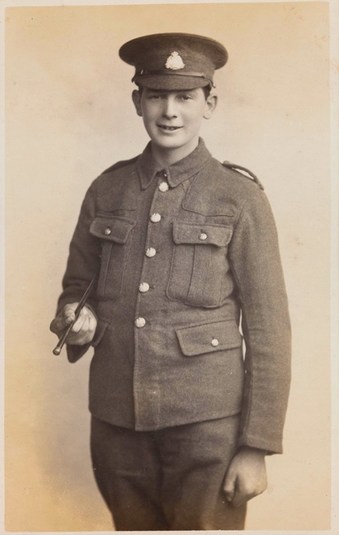
The 12th October was a black day in the history of The Suffolk Regiment. During the Great War the 7th Battalion lost over 500 men killed or wounded during a chaotic attack on 'Bayonet Trench' near the village of Gueudecourt in the souther sector of the Somme battlefield, and 28 years later, the 1st Battalion were engaged in the opening day of the battle of Overloon, where a carefully concealed sniper wreaked many casualties on the advancing Company.
At Bayonet trench, the decision by the Brigade Commander to send over all four Company's of the Battalion in an afternoon assault was confusing and chaotic. With such vast numbers of men on the battlefield, the bunched up, became entangled in one another and the Germans were able to mow them down from the heavily defenced position on the high ground in front of the Battalion. This tragic day for 7th Suffolk, was never expanded upon, nor reported in any great depth, and it perhaps suited the post-war generation of Regimental historians to quietly 'airbrush' it from history. The men were in no way to blame to the impetuses of their senior commanders, and behaved gallantly on the day, but it cost the Battalion dearly. They would not be at full strength again for many months.
In 1944, the casualties were greatly reduced, in fact only in tens, yet for a Battalion that had seen such high casualties at the Chateau de la Londe in June, then equally high casualties as it advanced south towards Tinchebray, these were the first major losses they had incurred after they had crossed into Holland. 'A' Company took the brunt of the losses, including the Company Commander being killed and nearly every senior NCO being wounded.
Spare a thought today for all those men of the Regiment, who like Private Leslie Symonds here, have since 1685, in many lands, given their lives for their country.
Posted: 12/10/2016
At Bayonet trench, the decision by the Brigade Commander to send over all four Company's of the Battalion in an afternoon assault was confusing and chaotic. With such vast numbers of men on the battlefield, the bunched up, became entangled in one another and the Germans were able to mow them down from the heavily defenced position on the high ground in front of the Battalion. This tragic day for 7th Suffolk, was never expanded upon, nor reported in any great depth, and it perhaps suited the post-war generation of Regimental historians to quietly 'airbrush' it from history. The men were in no way to blame to the impetuses of their senior commanders, and behaved gallantly on the day, but it cost the Battalion dearly. They would not be at full strength again for many months.
In 1944, the casualties were greatly reduced, in fact only in tens, yet for a Battalion that had seen such high casualties at the Chateau de la Londe in June, then equally high casualties as it advanced south towards Tinchebray, these were the first major losses they had incurred after they had crossed into Holland. 'A' Company took the brunt of the losses, including the Company Commander being killed and nearly every senior NCO being wounded.
Spare a thought today for all those men of the Regiment, who like Private Leslie Symonds here, have since 1685, in many lands, given their lives for their country.
Posted: 12/10/2016
A Phenomenal Success!
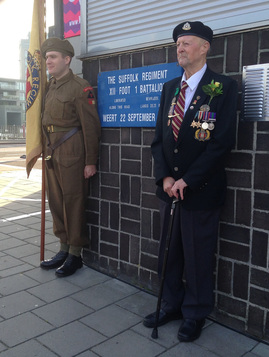
Fresh back from our trip to Holland, the Friends are buzzing with the culmination of our first, highly successful, Second World War battlefield tour.
Our trip to holland, which centered on our being asked to attend the annual service of commemoration at the Suffolk Regiment Memorial in Weert, was a great success. We toured the former battlefields of the 1st Battalion in 1944-45 and heard some of the stories of those who were there, and those who did not come home. Going to a few places off the beaten track, we heard of amazing people, performing amazing deeds, that gave the Regiment its highly respected reputation in the post-war years.
We were fortunate enough to have with us former 1/Suffolk veteran, Cecil Deller, who served with 'A' Company and he thoroughly enjoyed being treated like royalty in every place we visited!
A short write-up can be found on the 'Battlefield Tours' page of this website and a fuller, special colour supplement will be published in the next Friends magazine due out just before Christmas. We're planning to go to Bremen next year on a mini-trip - any takers?!
Posted: 26/09/2016
Our trip to holland, which centered on our being asked to attend the annual service of commemoration at the Suffolk Regiment Memorial in Weert, was a great success. We toured the former battlefields of the 1st Battalion in 1944-45 and heard some of the stories of those who were there, and those who did not come home. Going to a few places off the beaten track, we heard of amazing people, performing amazing deeds, that gave the Regiment its highly respected reputation in the post-war years.
We were fortunate enough to have with us former 1/Suffolk veteran, Cecil Deller, who served with 'A' Company and he thoroughly enjoyed being treated like royalty in every place we visited!
A short write-up can be found on the 'Battlefield Tours' page of this website and a fuller, special colour supplement will be published in the next Friends magazine due out just before Christmas. We're planning to go to Bremen next year on a mini-trip - any takers?!
Posted: 26/09/2016
Normal Service Will Be Resumed Shortly!
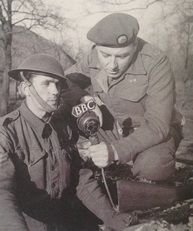
Its going to be a busy few days with us finishing one battlefield tour and then going onto another. We'll be dating our Facebook page as our tour in Holland progresses, but please check back soon for more news and updates to 'Operation Legacy'
Posted: 20/09/2016
Posted: 20/09/2016
2016 Somme Battlefield Tour
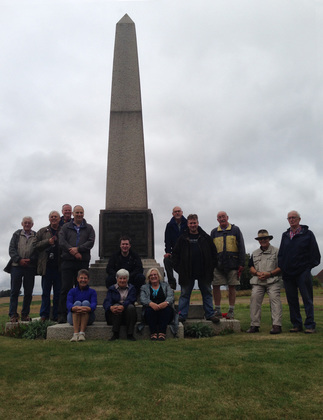
The Friends have just returned from the third in a series of yearly commemorative battlefield tours focusing on the specific actions of the various Battalions of The Suffolk Regiment during the Great War.
This years tour concentrated on the battles of the Somme in 1916 and saw us visit the battlefields of the six Suffolk Battalion involved in the battle. From Serre where 2nd Suffolk fought their "worst battle" in November, to Bayonet Trench where 7th Suffolk had a "calamitous day" in October, we visited in total eight locations on the Somme battlefields.
Perhaps most poignant, was the visit to La Boisselle to commemorate awful losses of the 11th Battalion; the only Suffolk Battalion engaged on the first day of the battle. Here we walked the ground with the original map carried by Lieutenant Gilbert Hattersley, who was wounded that very day.
In a campaign where 'disaster' has been the long tag line for over 50 years, we commemorated the successes too. At Thiepval on 26th September, the 8th battalion took the village and the ground beyond. It was, as the battle turned, a great allied victory.
A fuller report will be published in the next magazine and on the tours page of the website in due course.
Posted: 19/09/2016
This years tour concentrated on the battles of the Somme in 1916 and saw us visit the battlefields of the six Suffolk Battalion involved in the battle. From Serre where 2nd Suffolk fought their "worst battle" in November, to Bayonet Trench where 7th Suffolk had a "calamitous day" in October, we visited in total eight locations on the Somme battlefields.
Perhaps most poignant, was the visit to La Boisselle to commemorate awful losses of the 11th Battalion; the only Suffolk Battalion engaged on the first day of the battle. Here we walked the ground with the original map carried by Lieutenant Gilbert Hattersley, who was wounded that very day.
In a campaign where 'disaster' has been the long tag line for over 50 years, we commemorated the successes too. At Thiepval on 26th September, the 8th battalion took the village and the ground beyond. It was, as the battle turned, a great allied victory.
A fuller report will be published in the next magazine and on the tours page of the website in due course.
Posted: 19/09/2016
The Newest Friends Member Lives In......China!
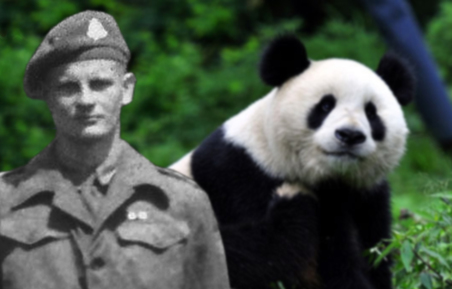
Today’s post brought a new membership form from a relative of Captain Arthur Woodward who won the Military Cross for his actions with 1/Suffolk at the Chateau de la Londe in June 1944. Great! we thought, until we clocked the postal address - Beijing!
Having gone through the membership list, this is a new record for the Friends. The award for farthest member was previously held by a former National Serviceman who served in Malaya but who now lives in Salmon Arm, British Columbia. This was however only a mere 4531 miles from Friends HQ. Our new member in Beijing is an additional 448 miles (4989 miles from Friends HQ) – so the race is now on to recruit a new member who is even further afield.
Via our Facebook page, this challenge may have already been met, with a potential new member being found in New Zealand. If anyone from Antartica wishes to join us, we'll send you a membership form and a free balaclava. Penguins can join at a reduced rate!
Posted: 05/09/2016
Having gone through the membership list, this is a new record for the Friends. The award for farthest member was previously held by a former National Serviceman who served in Malaya but who now lives in Salmon Arm, British Columbia. This was however only a mere 4531 miles from Friends HQ. Our new member in Beijing is an additional 448 miles (4989 miles from Friends HQ) – so the race is now on to recruit a new member who is even further afield.
Via our Facebook page, this challenge may have already been met, with a potential new member being found in New Zealand. If anyone from Antartica wishes to join us, we'll send you a membership form and a free balaclava. Penguins can join at a reduced rate!
Posted: 05/09/2016
Colonel Paul Long
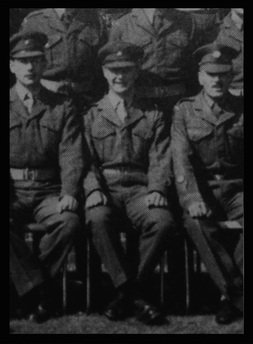
It is with much sadness that we have to report once more, the loss of another loyal Friends member, Colonel Paul Long, OBE, DL.
Paul, who came from a military family (his father having served in the Royal Flying Corps), was commissioned into 1st East Anglian Regiment [9 and 12] in 1962. His arrival with the 1st Battalion coincided with the return of the Battalion from their overseas tour in British Guiana and he joined them at Normandy Barracks, Felixstowe, later that year.
A keen shot, he was part of the 1st Battalion Rifle Team and was promoted Lieutenant in late 1964 as the Regiment became the 1st Battalion, the Royal Anglian Regiment, while they were stationed in Aden. Whilst there, Paul showed great flair as a young platoon commander (commanding 6 platoon, B Company) working in close co-operation with a squadron of armoured cars and Saladin's from nearby 4th Royal Tank Regiment, to great effect against the Radian tribesman.
It was during this period that Paul was seriously wounded when a booby-trapped road block was accidentally exploded by a member of his platoon. He was airlifted to the RAF hospital in Aden, where he made a swift recovery. He was soon back serving with the Battalion. Paul subsequently served with the 1st Battalion, at Celle in Germany, in Cyprus as part of the UN mission there, and later in Northern Ireland. Prior to his retirement, he commanded 5th Battalion the Royal Anglian Regiment, before taking up a 'retirement posting' as Commandant of the Stanford Training Area in Norfolk.
He was Honorary Colonel of A (Norfolk) Company, 6th Battalion, Royal Anglian Regiment and was in later years, Honorary Colonel of the Suffolk Army Cadet Force. Paul joined the Friends of The Suffolk Regiment many years ago and was, with the late Brigadier Bill Deller, a huge champion of our work. He was often to be seen at Regimental functions and gatherings, wearing his Suffolk Regiment tie.
John Raybold, a close friend and fellow Norfolk A.C.F. member, recently wrote of him; "Colonel Paul was a gentleman. A fine officer with a sense of humour who it was a pleasure to know." Our thoughts are with his widow, Sue, and his family at this difficult time.
Mark Forsdike
01/09/2016
Paul, who came from a military family (his father having served in the Royal Flying Corps), was commissioned into 1st East Anglian Regiment [9 and 12] in 1962. His arrival with the 1st Battalion coincided with the return of the Battalion from their overseas tour in British Guiana and he joined them at Normandy Barracks, Felixstowe, later that year.
A keen shot, he was part of the 1st Battalion Rifle Team and was promoted Lieutenant in late 1964 as the Regiment became the 1st Battalion, the Royal Anglian Regiment, while they were stationed in Aden. Whilst there, Paul showed great flair as a young platoon commander (commanding 6 platoon, B Company) working in close co-operation with a squadron of armoured cars and Saladin's from nearby 4th Royal Tank Regiment, to great effect against the Radian tribesman.
It was during this period that Paul was seriously wounded when a booby-trapped road block was accidentally exploded by a member of his platoon. He was airlifted to the RAF hospital in Aden, where he made a swift recovery. He was soon back serving with the Battalion. Paul subsequently served with the 1st Battalion, at Celle in Germany, in Cyprus as part of the UN mission there, and later in Northern Ireland. Prior to his retirement, he commanded 5th Battalion the Royal Anglian Regiment, before taking up a 'retirement posting' as Commandant of the Stanford Training Area in Norfolk.
He was Honorary Colonel of A (Norfolk) Company, 6th Battalion, Royal Anglian Regiment and was in later years, Honorary Colonel of the Suffolk Army Cadet Force. Paul joined the Friends of The Suffolk Regiment many years ago and was, with the late Brigadier Bill Deller, a huge champion of our work. He was often to be seen at Regimental functions and gatherings, wearing his Suffolk Regiment tie.
John Raybold, a close friend and fellow Norfolk A.C.F. member, recently wrote of him; "Colonel Paul was a gentleman. A fine officer with a sense of humour who it was a pleasure to know." Our thoughts are with his widow, Sue, and his family at this difficult time.
Mark Forsdike
01/09/2016
Major Richard Wilson
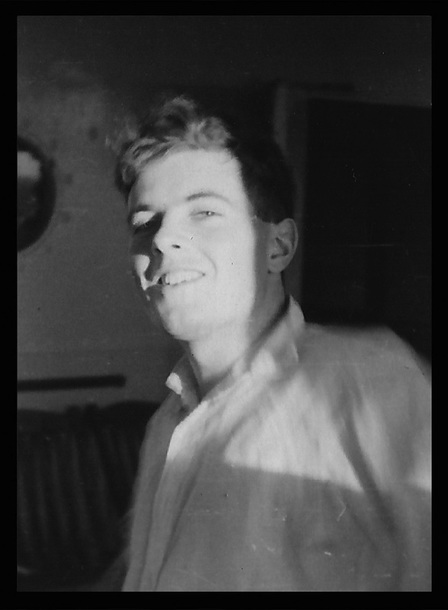
Today we learnt the sad news of the passing of Major Richard Wilson, formerly of 1st Suffolk, 4th Suffolk and later, the East Anglian and Royal Anglian Regiment's, who died after a long illness.
Richard George Wilson was commissioned from Sandhurst into the Suffolk Regiment in September 1951 and joined the 1st Battalion in Malaya the following April. Richard took over command of 3 Platoon, A Company and brought the platoon home in January 1953.
Following the Freedom Parades in Suffolk in the Spring of 1953, Richard along with Bill Deller, Eric Lummis and Bill Brinkley, formed the advance detachment to the Battalion’s next posting in Trieste. Richard was the last surviving member of that party.
In 1955 when 1/Suffolk were stationed at Wuppertal as part of B.A.O.R., he was Aide-de-Campe to H.R.H. The Princess Margaret on the occasion when she visited to present new Colours to the Battalion in 1955. Richard’s responsibility was to escort her from the airport and deliver her to the Officers Mess, from where the CO would greet her. The CO; Lieutenant-Colonel 'Tiny' Heal's instructions to him were quite specific as Richard later recalled; “Meet her, greet her, and give her whatever she wants!”
As the Battalion moved to Cyprus, Richard became the penultimate Adjutant of the 1st Battalion. It was a difficult time for Richard and for the Regiment as a whole. Amalgamation beckoned and the smooth merger of the two proud county regiments of Norfolk and Suffolk, had to be gently administered to ensure that both parties were happy with the final outcome. Both Regiment's had recently served in Cyprus where they had two very different styles of soldiering as Richard later remembered; “The Royal Norfolk’s were all spit and polish, whereas we Suffolk’s were quite a scruffy lot wearing desert boots in the mess and PT shorts at the bar – but it all came good in the end.”
At the time of Amalgamation, he was Temporary Captain and Quartermaster to 1/1st East Anglian Regiment, remaining with them at Iserlohn until November 1960, when he was called home to replace Captain Dean as Adjutant of the 4th (Territorial) Battalion at Ipswich. His posting to the Battalion was to ensure that as in Cyprus, he could administer the smooth amalgamation of the 4th Battalion, The Suffolk Regiment, to the 1st Battalion, The Cambridgeshire Regiment, to form the new Suffolk and Cambridgeshire Regiment (T.A.). After returning to the 1st Battalion, The Royal Anglian Regiment in 1965, he served with both the 3rd and 6th Battalions, before retiring as Major in 1975.
In his retirement, Richard spent a great deal of time on the Regimental Chapel Committee ensuring that it was well maintained and that through his party of volunteers, the flowers were changed regularly. Prior to his standing down from the committee, he oversaw the handover of the Chapel into the care of the Royal Anglian Regiment in 2008. In addition to this continued work, he also organised the annual meal for the Officers Dinner Club, which was held prior to Minden Day. He was a regular attendee until in the last few years, his poor health prevented him from attending.
Richard was until recently, an active member of his local branch of the Western Front Association in Norfolk and compiled their branch newsletter. He was also a long standing member of the Gallipoli Association, attending their annual lunches at the Guildhall in Kings Lynn. It was Richard along with fellow Friends member, Ron Mace, fought hard for many years to ensure that Sidney Day; a native of Norwich who won the Victoria Cross in 1917 whist serving with the 11th Battalion, had a lasting memorial in his home town. Their ambition will shortly come to fruition but, it is such a pity that neither Ron nor Richard lived to see their dream become a reality.
Richard cared passionately about the history of the Suffolk Regiment and was an early Friends member. We shall miss his support and guidance and we send our condolences to his widow and his family at this difficult time.
Mark Forsdike, 16/08/2016
With grateful thanks to Friend Pat Bird (a fellow subaltern) for the photograph of Richard above, taken onboard the troopship on the way home from Malaya in 1953.
Richard George Wilson was commissioned from Sandhurst into the Suffolk Regiment in September 1951 and joined the 1st Battalion in Malaya the following April. Richard took over command of 3 Platoon, A Company and brought the platoon home in January 1953.
Following the Freedom Parades in Suffolk in the Spring of 1953, Richard along with Bill Deller, Eric Lummis and Bill Brinkley, formed the advance detachment to the Battalion’s next posting in Trieste. Richard was the last surviving member of that party.
In 1955 when 1/Suffolk were stationed at Wuppertal as part of B.A.O.R., he was Aide-de-Campe to H.R.H. The Princess Margaret on the occasion when she visited to present new Colours to the Battalion in 1955. Richard’s responsibility was to escort her from the airport and deliver her to the Officers Mess, from where the CO would greet her. The CO; Lieutenant-Colonel 'Tiny' Heal's instructions to him were quite specific as Richard later recalled; “Meet her, greet her, and give her whatever she wants!”
As the Battalion moved to Cyprus, Richard became the penultimate Adjutant of the 1st Battalion. It was a difficult time for Richard and for the Regiment as a whole. Amalgamation beckoned and the smooth merger of the two proud county regiments of Norfolk and Suffolk, had to be gently administered to ensure that both parties were happy with the final outcome. Both Regiment's had recently served in Cyprus where they had two very different styles of soldiering as Richard later remembered; “The Royal Norfolk’s were all spit and polish, whereas we Suffolk’s were quite a scruffy lot wearing desert boots in the mess and PT shorts at the bar – but it all came good in the end.”
At the time of Amalgamation, he was Temporary Captain and Quartermaster to 1/1st East Anglian Regiment, remaining with them at Iserlohn until November 1960, when he was called home to replace Captain Dean as Adjutant of the 4th (Territorial) Battalion at Ipswich. His posting to the Battalion was to ensure that as in Cyprus, he could administer the smooth amalgamation of the 4th Battalion, The Suffolk Regiment, to the 1st Battalion, The Cambridgeshire Regiment, to form the new Suffolk and Cambridgeshire Regiment (T.A.). After returning to the 1st Battalion, The Royal Anglian Regiment in 1965, he served with both the 3rd and 6th Battalions, before retiring as Major in 1975.
In his retirement, Richard spent a great deal of time on the Regimental Chapel Committee ensuring that it was well maintained and that through his party of volunteers, the flowers were changed regularly. Prior to his standing down from the committee, he oversaw the handover of the Chapel into the care of the Royal Anglian Regiment in 2008. In addition to this continued work, he also organised the annual meal for the Officers Dinner Club, which was held prior to Minden Day. He was a regular attendee until in the last few years, his poor health prevented him from attending.
Richard was until recently, an active member of his local branch of the Western Front Association in Norfolk and compiled their branch newsletter. He was also a long standing member of the Gallipoli Association, attending their annual lunches at the Guildhall in Kings Lynn. It was Richard along with fellow Friends member, Ron Mace, fought hard for many years to ensure that Sidney Day; a native of Norwich who won the Victoria Cross in 1917 whist serving with the 11th Battalion, had a lasting memorial in his home town. Their ambition will shortly come to fruition but, it is such a pity that neither Ron nor Richard lived to see their dream become a reality.
Richard cared passionately about the history of the Suffolk Regiment and was an early Friends member. We shall miss his support and guidance and we send our condolences to his widow and his family at this difficult time.
Mark Forsdike, 16/08/2016
With grateful thanks to Friend Pat Bird (a fellow subaltern) for the photograph of Richard above, taken onboard the troopship on the way home from Malaya in 1953.
Friends Members (.....& D-Day Veterans) Reunited
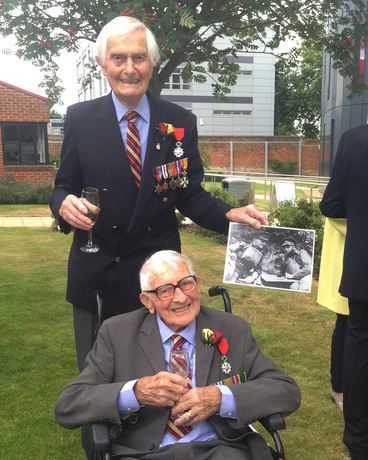
The highlight for us on Minden Day, was the bringing together D-Day veterans Ken Mayhew and Ron Rogers to recreate an historic picture taken of the two men in 1941.
Ken and Ron both joined the Suffolk Regiment in 1940, and after training in Scotland, went on to land on D-Day and serve in the NW Europe campaign. Ron was injured by mortar fire at Tinchebrai in August 1944, but returned to the Battalion in January 1945. Ken by wounded by shrapnel at Venray in October. Both men never lost their links with the Suffolk Regiment and have attended nearly every Regimental Pilgrimage to Normandy and Holland since tours began in 1984. At a special lunch organised to entertain our French counterparts, Les Amis du Suffolk Regiment, the two men were together for the first time in several months, although they have kept in continuous contact with one another since 1945. Both have recently been awarded the Legion d'Honneur by the French government and it was great to see them both proudly wearing their medals.
The photograph that Ken holds, shows him and Ron on Salisbury Plain in 1941, when the Battalion were on manoeuvres. The Friends though that as the two would be together again, that it was important to re-stage the scene as it was 77 years ago. It was the highlight to an already great day.
(Posted: 02/08/2016)
Ken and Ron both joined the Suffolk Regiment in 1940, and after training in Scotland, went on to land on D-Day and serve in the NW Europe campaign. Ron was injured by mortar fire at Tinchebrai in August 1944, but returned to the Battalion in January 1945. Ken by wounded by shrapnel at Venray in October. Both men never lost their links with the Suffolk Regiment and have attended nearly every Regimental Pilgrimage to Normandy and Holland since tours began in 1984. At a special lunch organised to entertain our French counterparts, Les Amis du Suffolk Regiment, the two men were together for the first time in several months, although they have kept in continuous contact with one another since 1945. Both have recently been awarded the Legion d'Honneur by the French government and it was great to see them both proudly wearing their medals.
The photograph that Ken holds, shows him and Ron on Salisbury Plain in 1941, when the Battalion were on manoeuvres. The Friends though that as the two would be together again, that it was important to re-stage the scene as it was 77 years ago. It was the highlight to an already great day.
(Posted: 02/08/2016)
Another Great Minden Day
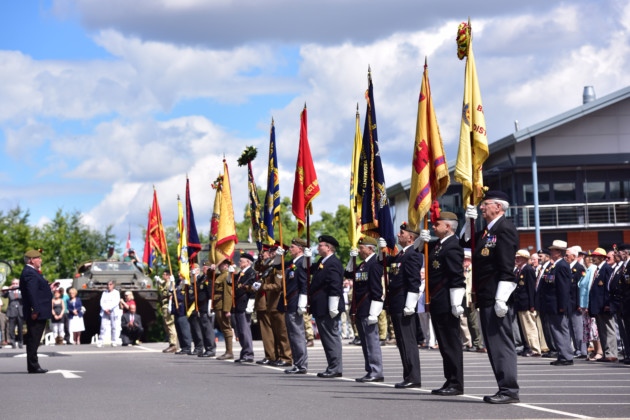
Another great Minden Day has come and gone, but there was no denying this year, that Suffolk Regiment veterans were getting fewer in number than previous years.
In an action-packed day, which saw first, the unveiling Sergeant Arthur Saunders Victoria Cross in the Regimental Museum (in its special display case), the march past of the massed ranks of the Old Comrades Association at noon was the highlight of the day. To the strains of "Speed the Plough" those who could, proudly marched behind their Branch Standards onto what remains of the old barrack square.
With the ravages of time, we have lost our Pre-war Regulars, our Second World War veterans, and now the seemingly ever-plentiful ranks of National Servicemen are fading fast.
It was sad to think that in our lifetime, these men had faded away, but with new members joining the Friends on Sunday, many of whom were descendents of those who had served in the 'Old Dozen' it strengthens us to know that there are many out there who will ensure that the Regiment will never be forgotten. Lets hope we can keep holding Minden Day's for a few years yet!
(Posted: 01/08/2016)
Photograph, courtesy of the East Anglian Daily Times
In an action-packed day, which saw first, the unveiling Sergeant Arthur Saunders Victoria Cross in the Regimental Museum (in its special display case), the march past of the massed ranks of the Old Comrades Association at noon was the highlight of the day. To the strains of "Speed the Plough" those who could, proudly marched behind their Branch Standards onto what remains of the old barrack square.
With the ravages of time, we have lost our Pre-war Regulars, our Second World War veterans, and now the seemingly ever-plentiful ranks of National Servicemen are fading fast.
It was sad to think that in our lifetime, these men had faded away, but with new members joining the Friends on Sunday, many of whom were descendents of those who had served in the 'Old Dozen' it strengthens us to know that there are many out there who will ensure that the Regiment will never be forgotten. Lets hope we can keep holding Minden Day's for a few years yet!
(Posted: 01/08/2016)
Photograph, courtesy of the East Anglian Daily Times
The End Of An Era
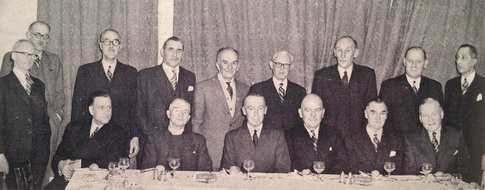
Today we learnt of the sad news that this Saturday's Officers Dinner Club lunch will be the very last.
After 64 years, the retired officers of the Old Twelfth will meet no more. The club, which was formally created in the autumn of 1952, had its roots in many smaller Battalion dining clubs that had been meeting since the early 1920s. The first of these clubs were the officers of the 2nd Battalion who met twice yearly at the Trocadero in London. This club included men who had served with the Battalion during the Great War, which included many who had been captured at Le Cateau.
In early 1952, over 500 letters were sent out to all known officers of the Suffolk Regiment (both serving and retired) proposing the creation of a formalised club. The response was far better than expected with 231 serving and retired officers send the proposed subscription by return. Though termed a 'club' it was really an association, but the word 'association' was not chosen, less it confuse the club with the Old Comrades Association. Different subscription rates were proposed for serving and retired officers, a proportion of either were to be donated to the War Memorial Homes, the Old Comrades Association and the Regimental Gazette respectively.
Such was the success of the club that the following year in 1953, it was decided to incorporate the Officers Golfing Society into the club as well and by March, just four months after its creation, membership had topped 250, with many National Service Officers joining following the Battalion's return from Malaya. By 1960, membership was at almost 350, but with amalgamation, the numbers gradually started to decline. The club continued to meet over the years despite seeing many of its members pass on, but widows were always welcome and so were the children of Suffolk officers. The spirit of the family Regiment lived on through the club. As the Depot closed in the late 1960s, the club met at both the Atheneum and the Angel Hotel in Bury St. Edmunds, before moving in more recent years, to meet for lunch instead of dinner at Culford School.
In the lifetime of the Friends, we have seen the handing over of the Regimental Memorial Homes to Haig Homes for their onwards care, the safety of the Regimental Chapel handed to our descendent Regiment, and now with the ending of the Officers Dinner Club, the very end of the Suffolk Regiment seems upon us. Let us the Friends, ensure that we keep the spirit alive long after the living face of the Regiment has left us.
(Posted: 25/07/2016)
After 64 years, the retired officers of the Old Twelfth will meet no more. The club, which was formally created in the autumn of 1952, had its roots in many smaller Battalion dining clubs that had been meeting since the early 1920s. The first of these clubs were the officers of the 2nd Battalion who met twice yearly at the Trocadero in London. This club included men who had served with the Battalion during the Great War, which included many who had been captured at Le Cateau.
In early 1952, over 500 letters were sent out to all known officers of the Suffolk Regiment (both serving and retired) proposing the creation of a formalised club. The response was far better than expected with 231 serving and retired officers send the proposed subscription by return. Though termed a 'club' it was really an association, but the word 'association' was not chosen, less it confuse the club with the Old Comrades Association. Different subscription rates were proposed for serving and retired officers, a proportion of either were to be donated to the War Memorial Homes, the Old Comrades Association and the Regimental Gazette respectively.
Such was the success of the club that the following year in 1953, it was decided to incorporate the Officers Golfing Society into the club as well and by March, just four months after its creation, membership had topped 250, with many National Service Officers joining following the Battalion's return from Malaya. By 1960, membership was at almost 350, but with amalgamation, the numbers gradually started to decline. The club continued to meet over the years despite seeing many of its members pass on, but widows were always welcome and so were the children of Suffolk officers. The spirit of the family Regiment lived on through the club. As the Depot closed in the late 1960s, the club met at both the Atheneum and the Angel Hotel in Bury St. Edmunds, before moving in more recent years, to meet for lunch instead of dinner at Culford School.
In the lifetime of the Friends, we have seen the handing over of the Regimental Memorial Homes to Haig Homes for their onwards care, the safety of the Regimental Chapel handed to our descendent Regiment, and now with the ending of the Officers Dinner Club, the very end of the Suffolk Regiment seems upon us. Let us the Friends, ensure that we keep the spirit alive long after the living face of the Regiment has left us.
(Posted: 25/07/2016)
Remembering Bill
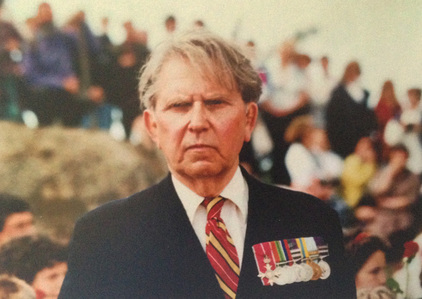
On Monday we bade a final farewell to a long time Friends member, Brigadier Bill Deller.
Bill's memorial service at St Mary's church in Bury St. Edmunds was for many of us the end of an era. He had been with us from our creation and he had nurtured and pushed us to become the great organisation we are today. His unfailing confidence in the success of the Friends and his untiring support of our aims and objectives, will be greatly missed.
In a packed church, family, friends and colleagues from his service in the Suffolk, East Anglian and Royal Anglian Regiment's were present. Colonel Paul Long, himself commissioned into 1/1st East Anglian Regiment, delivered the eulogy, which encompassed Bill's glittering military and diplomatic career. It was mentioned of Bill that he was a thoughtful and clear headed soldier, a fine diplomat and together with his late wife, Dierdre, outstanding ambassadors for the United Kingdom abroad.
Reflective too of Bill's character, was his own choice of hymns, the final one being "Mine Eyes Have Seen The Glory Of The Coming Of The Lord" a hymn chosen by the Old Contemptibles Association for their own, and a hymn requested by Churchill at his own memorial service. A fitting closure to a service of remembrance to a great solider and statesman.
Bill was an officer, historian and a true gentleman. We are all the poorer for his passing.
(Posted: 20/07/2016)
Bill's memorial service at St Mary's church in Bury St. Edmunds was for many of us the end of an era. He had been with us from our creation and he had nurtured and pushed us to become the great organisation we are today. His unfailing confidence in the success of the Friends and his untiring support of our aims and objectives, will be greatly missed.
In a packed church, family, friends and colleagues from his service in the Suffolk, East Anglian and Royal Anglian Regiment's were present. Colonel Paul Long, himself commissioned into 1/1st East Anglian Regiment, delivered the eulogy, which encompassed Bill's glittering military and diplomatic career. It was mentioned of Bill that he was a thoughtful and clear headed soldier, a fine diplomat and together with his late wife, Dierdre, outstanding ambassadors for the United Kingdom abroad.
Reflective too of Bill's character, was his own choice of hymns, the final one being "Mine Eyes Have Seen The Glory Of The Coming Of The Lord" a hymn chosen by the Old Contemptibles Association for their own, and a hymn requested by Churchill at his own memorial service. A fitting closure to a service of remembrance to a great solider and statesman.
Bill was an officer, historian and a true gentleman. We are all the poorer for his passing.
(Posted: 20/07/2016)
What Are The Chances Of That Happening?
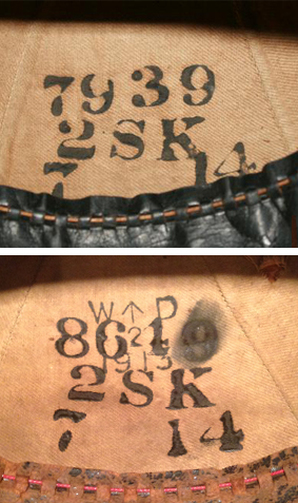
Back in March we brought you news of how a rare surviving 2nd Suffolk Home Service helmet was recently sold. Well, yesterday, another almost identical helmet appeared for sale and we were lucky enough to secure it.
The first helmet belonged to Private E.J Brown, who joined the Regiment in 1910 but who was killed at Vierstraat in 1915. The second helmet was once the property of 8649 Private William Smart, who joined the Regiment on the 12th February 1913.
Both helmets were marked with an issue date of July 1914 so it is probable that at the Curragh, men with worn out kit, were given new replacement items. Both helmets were manufactured in 1913, and both contained stamps on the inside for the "Aldershot Military Tattoo."
The tattoo was a yearly event to celebrate the pageantry of the Army and its past campaigns. A stock of 'costumes' were kept in store for the event and were brought out each year for the three day event. After the tattoo ceased to be held in the 1950s, the helmets were most likely issued to a Cadet band which has in recent years, sold them on, to raise funds.
What is remarkable however, is the unfolding story of Bill Smart. A native of the Fenland village of Welney, both he and his brother George, enlisted into the Suffolk Regiment on the same day and were issued with consecutive service numbers (William 8649 and George 8650). Both men stayed together in the 2nd Battalion and both crossed to France on the 15th August 1914. Both saw action at Le Cateau, but George was killed on 26th August 1914, whilst William, though wounded, was able to get away to safety. He would however survive the war.
Another great survivor, the full story of which will be published in a future edition of our magazines.
(Posted: 14/07/2016)
The first helmet belonged to Private E.J Brown, who joined the Regiment in 1910 but who was killed at Vierstraat in 1915. The second helmet was once the property of 8649 Private William Smart, who joined the Regiment on the 12th February 1913.
Both helmets were marked with an issue date of July 1914 so it is probable that at the Curragh, men with worn out kit, were given new replacement items. Both helmets were manufactured in 1913, and both contained stamps on the inside for the "Aldershot Military Tattoo."
The tattoo was a yearly event to celebrate the pageantry of the Army and its past campaigns. A stock of 'costumes' were kept in store for the event and were brought out each year for the three day event. After the tattoo ceased to be held in the 1950s, the helmets were most likely issued to a Cadet band which has in recent years, sold them on, to raise funds.
What is remarkable however, is the unfolding story of Bill Smart. A native of the Fenland village of Welney, both he and his brother George, enlisted into the Suffolk Regiment on the same day and were issued with consecutive service numbers (William 8649 and George 8650). Both men stayed together in the 2nd Battalion and both crossed to France on the 15th August 1914. Both saw action at Le Cateau, but George was killed on 26th August 1914, whilst William, though wounded, was able to get away to safety. He would however survive the war.
Another great survivor, the full story of which will be published in a future edition of our magazines.
(Posted: 14/07/2016)
Roald Dahl & The Suffolk Regiment - Can You Help?
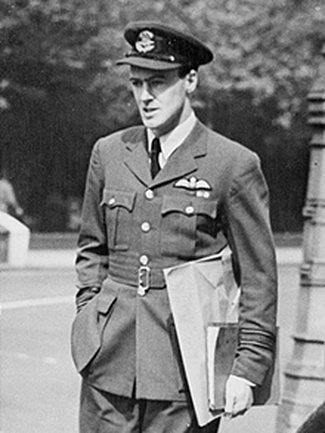
This weekend we got an email via the Friends website from a journalist working on a story for the centenary of Roald Dahl’s birth, who picked up that the Suffolk Regiment were mentioned in his biography in connection with an air crash Dahl suffered in September 1940 in the western desert.
In the authorised biography of Dahl’s life, it mentions of how he was delivering a new aircraft from his base in Iraq, to an airfield in the desert. He couldn’t locate the airfield and in failing light, he was forced to crash land. The aircraft overturned on landing, knocking him unconscious. When he came too, the aircraft was on fire but he managed to get out and crawl away, but badly burned, he dropped again into unconsciousness.
According to the book, he was rescued the following morning by three soldiers of The Suffolk Regiment in an area of no-mans-land between the British and Italian lines. This is a great story, but there is one small problem…there were no units of The Suffolk Regiment serving in North Africa in September 1940.
To the best our knowledge, the 1st, 4th, 5th , 7th , 8th, 13th and 31st Battalions were all in the UK with only the 2nd on Internal Security in India. If they were Suffolk soldiers, then they must have been on secondment to another unit. Maybe they were not Suffolks, but Surreys or Sussex? and perhaps the biographer made a mistake? If anyone had any firm evidence to back up the “authorised” story and prove that elements of The Suffolk Regiment were is the desert at this time, please let us know. It would be great to get a mention of the Friends in the national press!
(Posted: 11/07/2016)
In the authorised biography of Dahl’s life, it mentions of how he was delivering a new aircraft from his base in Iraq, to an airfield in the desert. He couldn’t locate the airfield and in failing light, he was forced to crash land. The aircraft overturned on landing, knocking him unconscious. When he came too, the aircraft was on fire but he managed to get out and crawl away, but badly burned, he dropped again into unconsciousness.
According to the book, he was rescued the following morning by three soldiers of The Suffolk Regiment in an area of no-mans-land between the British and Italian lines. This is a great story, but there is one small problem…there were no units of The Suffolk Regiment serving in North Africa in September 1940.
To the best our knowledge, the 1st, 4th, 5th , 7th , 8th, 13th and 31st Battalions were all in the UK with only the 2nd on Internal Security in India. If they were Suffolk soldiers, then they must have been on secondment to another unit. Maybe they were not Suffolks, but Surreys or Sussex? and perhaps the biographer made a mistake? If anyone had any firm evidence to back up the “authorised” story and prove that elements of The Suffolk Regiment were is the desert at this time, please let us know. It would be great to get a mention of the Friends in the national press!
(Posted: 11/07/2016)
The Cambridgeshire Regiment Remembered
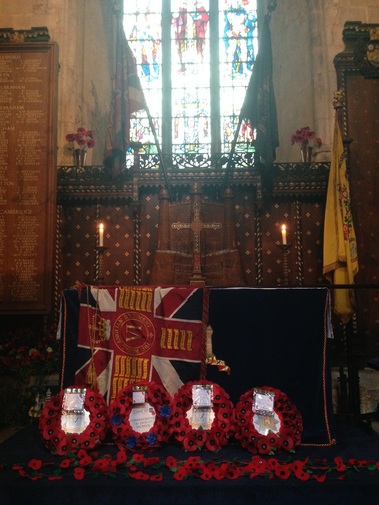
Last weekend, the Friends visited the excellent exhibition in Ely Museum organised by our good friends behind the Cambridgeshire Regiment 1914-18 website.
In a small room, a fantastic array of Cambridgeshire Regimented-related artefacts and photographs were displayed. Amongst the amazing treasures were the medals of three of the Cambridgeshire's former commanding officers: Lieutenant-Colonel Louis Tebbutt, Colonel Charles Copeman and Lieutenant-Colonel Goodwyn Archer. It was probably the first time since the Great War, that all three groups had been together.
For us however, the highlight was to see an original shoulder strap from a tunic of a soldier of 11th Suffolk (Cambs) with its unique shoulder title and yellow woollen tape.After such an excellent exhibition, we ventured to the cathedral to attend the Cambridgeshire Regiment Association's annual service of commemoration in the presence of H.R.H. The Duke of Gloucester; Colonel-in-Chief of the Royal Anglian Regiment. During the ceremony, the old Queen's Colour of the 6th (Volunteer) Battalion, The Royal Anglian Regiment was handed to the Cathedral for its safekeeping. It was taken to the Cambridgeshire Regiment Chapel where it was laid upon the altar.
Afterwards, tea was available and a chance to view another exhibition in the cathedral, with displays by the Royal Anglian Regiment Museum, the Cambridgeshire Army Cadet Force and the Cambs876 team.
It is great to see our cousins in the Fens being so we'll remembered. Like the Suffolk Regiment, they have dedicated historians who will ensure that will not be forgotten.
(Posted: 10/07/2016)
In a small room, a fantastic array of Cambridgeshire Regimented-related artefacts and photographs were displayed. Amongst the amazing treasures were the medals of three of the Cambridgeshire's former commanding officers: Lieutenant-Colonel Louis Tebbutt, Colonel Charles Copeman and Lieutenant-Colonel Goodwyn Archer. It was probably the first time since the Great War, that all three groups had been together.
For us however, the highlight was to see an original shoulder strap from a tunic of a soldier of 11th Suffolk (Cambs) with its unique shoulder title and yellow woollen tape.After such an excellent exhibition, we ventured to the cathedral to attend the Cambridgeshire Regiment Association's annual service of commemoration in the presence of H.R.H. The Duke of Gloucester; Colonel-in-Chief of the Royal Anglian Regiment. During the ceremony, the old Queen's Colour of the 6th (Volunteer) Battalion, The Royal Anglian Regiment was handed to the Cathedral for its safekeeping. It was taken to the Cambridgeshire Regiment Chapel where it was laid upon the altar.
Afterwards, tea was available and a chance to view another exhibition in the cathedral, with displays by the Royal Anglian Regiment Museum, the Cambridgeshire Army Cadet Force and the Cambs876 team.
It is great to see our cousins in the Fens being so we'll remembered. Like the Suffolk Regiment, they have dedicated historians who will ensure that will not be forgotten.
(Posted: 10/07/2016)
The Friends Participation In The National Centenary of The Great War
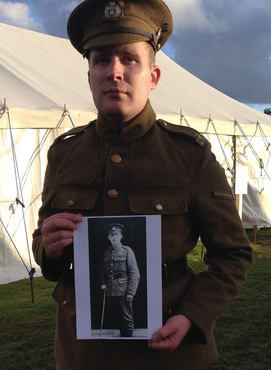
Today, a service of commemoration in Ely cathedral for the Cambridgeshire Regiment brought to an end, four somewhat manic, but memorable days for the Friends.
On Thursday evening, Friends members Tim and Pip Davies attended the Service of Remembrance at Westminster Abbey in the company of Her Majesty The Queen. At the end of the service, the first members of a nightly vigil to stand guard over the Tomb of the Unknown Warrior, included Friends Secretary Mark Forsdike and Friends Chairman, Taff Gillingham. Wearing roses in their lapels (in honour of the "Dettingen" tradition that when the Monarch is present, roses will be worn), together with Suffolk Regiment ties in their top pockets, they mounted guard over the Tomb. The 'Minden Boys' were certainly not forgotten that day.
The following day, national attention then shifted to Manchester where on Friday evening, a concert was held headed by the world-famous Halle Orchestra; whose most famous conductor was Sir John Barbirolli, served with the 1st (Reserve) Garrison Battalion on the Isle of Grain in Kent in 1918. As the concert progressed, a reading of Charles Hamilton Sorley's poem "When You See Millions Of The Mouthless Dead" continued throughout a torrential thunderstorm, which concluded by two rainbows emerging on the horizon. Sorley having served in 7th Suffolk at the Battle of Loos in 1915 where he was killed attacking 'Hairpin' trench.
Finally today, the Cambridgeshire Regiment held their annual service of remembrance at Ely Cathedral to remember their 1st Battalion's attack on the Schwarben Redoubt later in the Somme Campaign. Suffolk Regiment ties, thought in a very small minority, we're still to be seen in the congregation.
The Suffolk Regiment has been very well represented in the national commemorations, due in no small part to Taff being an advisor on the national committee that organised the entire proceedings. We're very pleased and honoured that our members have played such important and prominent parts in the last few days of commemorations, and now 100 years on, we are proud that the deeds of their relations and forebears will in no way be forgotten.
"Stabilis"
(Posted: 03/07/2016)
On Thursday evening, Friends members Tim and Pip Davies attended the Service of Remembrance at Westminster Abbey in the company of Her Majesty The Queen. At the end of the service, the first members of a nightly vigil to stand guard over the Tomb of the Unknown Warrior, included Friends Secretary Mark Forsdike and Friends Chairman, Taff Gillingham. Wearing roses in their lapels (in honour of the "Dettingen" tradition that when the Monarch is present, roses will be worn), together with Suffolk Regiment ties in their top pockets, they mounted guard over the Tomb. The 'Minden Boys' were certainly not forgotten that day.
The following day, national attention then shifted to Manchester where on Friday evening, a concert was held headed by the world-famous Halle Orchestra; whose most famous conductor was Sir John Barbirolli, served with the 1st (Reserve) Garrison Battalion on the Isle of Grain in Kent in 1918. As the concert progressed, a reading of Charles Hamilton Sorley's poem "When You See Millions Of The Mouthless Dead" continued throughout a torrential thunderstorm, which concluded by two rainbows emerging on the horizon. Sorley having served in 7th Suffolk at the Battle of Loos in 1915 where he was killed attacking 'Hairpin' trench.
Finally today, the Cambridgeshire Regiment held their annual service of remembrance at Ely Cathedral to remember their 1st Battalion's attack on the Schwarben Redoubt later in the Somme Campaign. Suffolk Regiment ties, thought in a very small minority, we're still to be seen in the congregation.
The Suffolk Regiment has been very well represented in the national commemorations, due in no small part to Taff being an advisor on the national committee that organised the entire proceedings. We're very pleased and honoured that our members have played such important and prominent parts in the last few days of commemorations, and now 100 years on, we are proud that the deeds of their relations and forebears will in no way be forgotten.
"Stabilis"
(Posted: 03/07/2016)
Remember The First Day Of The Battle Of The Somme:
1.7.1916 - 1.7. 2016
Remember today, the men of the 11th (Service) Battalion, The Suffolk Regiment (Cambridgeshire) who went over the top at 7.30 am on the morning of 1st July 1916 at La Boiselle on the first day of the Battle of the Somme.
The casualties sustained by 11th Suffolk that day were the highest of any Battalion in the 34th Division. 691 all-ranks including 19 officers. Of these, 190 were killed that first day, with 337 were wounded. Many more would die as a result of wounds received in the days that were to follow. Of those 190, a staggering 148 have no known grave and are commemorated on the Commonweath War Graves Memorial to the missing at Thiepval.
The first day of the Battle of the Somme was a black day in the history of The Suffolk Regiment. Not at Le Cateau, Neuve-Chapelle, Frezenberg or Loos, had one single Battalion of the Regiment suffered so high amount of casualties on a single day. However, despite these heavy British losses, the German Armies were dealt a severe blow on the Somme; a blow from which they never recovered.
Spare a thought today for all those men of the Battalion who died that day and who never had a chance to use their return tickets to Blighty.
We will remember them.
(Posted: 01/07/2016)
The casualties sustained by 11th Suffolk that day were the highest of any Battalion in the 34th Division. 691 all-ranks including 19 officers. Of these, 190 were killed that first day, with 337 were wounded. Many more would die as a result of wounds received in the days that were to follow. Of those 190, a staggering 148 have no known grave and are commemorated on the Commonweath War Graves Memorial to the missing at Thiepval.
The first day of the Battle of the Somme was a black day in the history of The Suffolk Regiment. Not at Le Cateau, Neuve-Chapelle, Frezenberg or Loos, had one single Battalion of the Regiment suffered so high amount of casualties on a single day. However, despite these heavy British losses, the German Armies were dealt a severe blow on the Somme; a blow from which they never recovered.
Spare a thought today for all those men of the Battalion who died that day and who never had a chance to use their return tickets to Blighty.
We will remember them.
(Posted: 01/07/2016)
Brigadier W.C. Deller O.B.E.
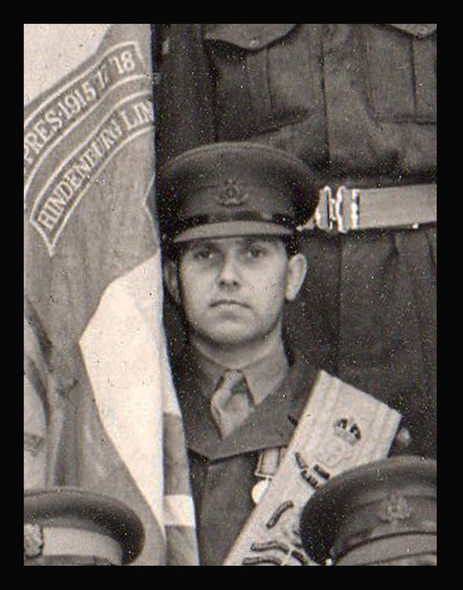
It is with profound personal sadness that we report the passing of Brigadier Bill Deller, OBE, formerly the President of The Suffolk Regiment Old Comrades Association and an early Friends member.
Born at Duxford in 1928, his father owned the local diary that supplied the airfield that is now the Imperial War Museum. Cadet William Charles Deller was commissioned from Sandhurst into The Suffolk Regiment on 9th August 1946. He was one of five officers to join the Regiment that day; the first post-war class of Cadets. Bill joined 1 Suffolk in Palestine later that year and was soon thrown into the chaos of the troubled land.
His military service for his country had begun however three years previously, when he volunteered as a runner for his local Home Guard detachment in Cambridgeshire. For his services, he was awarded the Defence Medal; which he proudly wore the ribbon of when he joined 1 Suffolk in Palestine. He later recalled meeting the Adjutant upon his arrival who sharply commented “I’d remove that before you go into see the Old Man, he doesn’t approve of gallant subalterns!” Needless to say, the ribbon promptly disappeared.
Bill’s service in Palestine was one of Internal Security. Daily they checked the loaded troopships of Jewish refugees arriving, and daily they were spat at and had the contents of lavatory buckets thrown over them, yet here Bill saw the true Suffolk soldier. A man who quietly got on with his job no matter what was thrown at him. It was from that moment that he was ceaseless in his activities and efforts for the Old Comrades Association and its members.
From Palestine, where he had been almost the last man to leave the City of Jerusalem taking with him the last Union Flag to fly over the city, he travelled to Greece where for a short interlude, the Battalion were stationed in Salonika. From here, he went to Malaya, arriving there on the advance party in July 1949. He participated in one of the first patrols B Company launched into the jungle and they were successful in capturing two terrorists. In early 1951, Bill participated in an inter-Battalion posting to join the 1st Battalion, Royal Norfolk Regiment, then stationed in Korea. In return, the Battalion received two Norfolk officers. Bill was therefore part of a small unique band of three Suffolk soldiers who were to be awarded the British Korea and the UN Medal for the campaign. He returned to 1 Suffolk in Malaya in June 1952, where he was made Temporary Captain.
Bill commanded A Company of 1 Suffolk upon their return to the UK and continued to command the Company when they arrived in Trieste in mid-1953. As the Battalion moved to Germany in 1954, he was promoted to Adjutant and was still in this position when H.R.H. The Princess Margaret came to present new Colours to the Battalion in May 1955. Bill was away serving with the Aden Protectorate Levies when amalgamation came. He returned to join 1/1st East Anglian Regiment at Felixstowe in 1963.
Following the creation of the new larger, Royal Anglian Regiment in 1964, he served in Radfan and Aden, before returning home to take command of the East Anglian Brigade Depot which it was proposed, would be situated at the redundant RAF Barham airfield, near Bury St. Edmunds, but at the last minute, another old airfield, RAF Bassingbourn, became available. Bill, now Lieutenant-Colonel, was the first Depot Commander there.
Born at Duxford in 1928, his father owned the local diary that supplied the airfield that is now the Imperial War Museum. Cadet William Charles Deller was commissioned from Sandhurst into The Suffolk Regiment on 9th August 1946. He was one of five officers to join the Regiment that day; the first post-war class of Cadets. Bill joined 1 Suffolk in Palestine later that year and was soon thrown into the chaos of the troubled land.
His military service for his country had begun however three years previously, when he volunteered as a runner for his local Home Guard detachment in Cambridgeshire. For his services, he was awarded the Defence Medal; which he proudly wore the ribbon of when he joined 1 Suffolk in Palestine. He later recalled meeting the Adjutant upon his arrival who sharply commented “I’d remove that before you go into see the Old Man, he doesn’t approve of gallant subalterns!” Needless to say, the ribbon promptly disappeared.
Bill’s service in Palestine was one of Internal Security. Daily they checked the loaded troopships of Jewish refugees arriving, and daily they were spat at and had the contents of lavatory buckets thrown over them, yet here Bill saw the true Suffolk soldier. A man who quietly got on with his job no matter what was thrown at him. It was from that moment that he was ceaseless in his activities and efforts for the Old Comrades Association and its members.
From Palestine, where he had been almost the last man to leave the City of Jerusalem taking with him the last Union Flag to fly over the city, he travelled to Greece where for a short interlude, the Battalion were stationed in Salonika. From here, he went to Malaya, arriving there on the advance party in July 1949. He participated in one of the first patrols B Company launched into the jungle and they were successful in capturing two terrorists. In early 1951, Bill participated in an inter-Battalion posting to join the 1st Battalion, Royal Norfolk Regiment, then stationed in Korea. In return, the Battalion received two Norfolk officers. Bill was therefore part of a small unique band of three Suffolk soldiers who were to be awarded the British Korea and the UN Medal for the campaign. He returned to 1 Suffolk in Malaya in June 1952, where he was made Temporary Captain.
Bill commanded A Company of 1 Suffolk upon their return to the UK and continued to command the Company when they arrived in Trieste in mid-1953. As the Battalion moved to Germany in 1954, he was promoted to Adjutant and was still in this position when H.R.H. The Princess Margaret came to present new Colours to the Battalion in May 1955. Bill was away serving with the Aden Protectorate Levies when amalgamation came. He returned to join 1/1st East Anglian Regiment at Felixstowe in 1963.
Following the creation of the new larger, Royal Anglian Regiment in 1964, he served in Radfan and Aden, before returning home to take command of the East Anglian Brigade Depot which it was proposed, would be situated at the redundant RAF Barham airfield, near Bury St. Edmunds, but at the last minute, another old airfield, RAF Bassingbourn, became available. Bill, now Lieutenant-Colonel, was the first Depot Commander there.
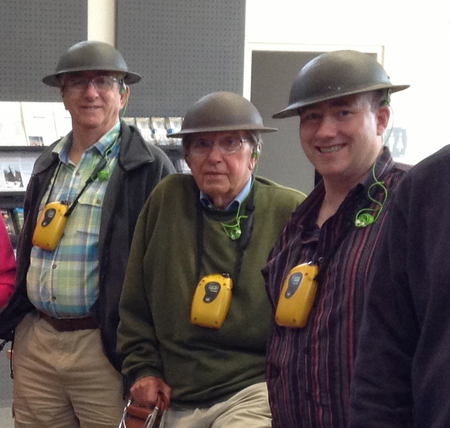
Awarded the O.B.E. in 1971, he continued to serve with 1 Royal Anglian interspersed with spells in Staff positions at the Ministry of Defence. In 1978 Bill was promoted Colonel and made Defence Attaché to the British Embassy in Washington. The then Head of Chancellery was a fellow Suffolk Regiment man, John Killick, who had been captured at Arnhem. Bill and his wife Deidre were ‘flavour of the month’ when they arrived for they brought with them from England, a considerable stock of marmite which was then, virtually unobtainable in the US!
From here in 1980, he was made the British Defence Advisor to Pakistan and promoted Brigadier. He remained here on the Staff for two years even though he had been officially placed on the Retired List in late 1982. He remained in the post for an additional twelve months, but was keen to get home for the tri-centenary of The Suffolk Regiment was fast approaching and his old comrade; Lieutenant-General Sir Richard "Dick" Goodwin, had planned a mammoth series of events to celebrate this important Regimental anniversary.
In 1986, Dick Goodwin died suddenly. The vacuum left by his passing forced a new generation of Suffolk officers to the fore in the OCA committee. Colonel W.A. Heal stood in temporarily as President, but in 1987, Bill accepted the Presidency; a roll he was to remain in until 2009, when he stood down to make way for Brigadier Tony Calder, a man he had first met as a young subaltern in the Radfan in 1965.
Bill was a great Regimental Historian, and was always acutely aware that when he took over as President, the Regiment lacked the final volume of it's Regimental History (from 1947 until 1959). Therefore one of his first missions as President, was to task Major Bob Godfrey to write the 4th volume. It was published in 1988. Bill was however also aware, that once the living face of the Regiment disappeared, its legacy would be no more than a handful of books and photographs. It was this stark reality that urged him to get the Imperial War Museum, to record as many of the living members of the Regiment as was possible throughout the 1980s and 1990s, and today, Bill's legacy is over 300 hours of personal testimonies held in the sound archives of the IWM. Bill too, was never too proud to borrow an idea if it was successful. At the suggestion of Taff Gillingham, that their counterparts in Essex were sending out a Regimental Questionnaire to all surviving members of the Regiment, Bill insisted that The Suffolk Regiment did the same!
For Bill the devil was in the detail. After each copy of our magazines were published, he would give us his corrections and observations. He was keen to make sure that we got the detail right, and that our publications recorded the true history of The Suffolk Regiment. In 2008 when the Friends were formed, Bill became member number 10 and delighted in sending us a cheque for his subscription upon which he wrote: “Here’s ten years worth. If I get that far, please let me know and I’ll give you another ten years worth!” He was hugely supportive of the Friends and was instrumental in boosting our membership in the early days by a personal 'hounding' of many of his friends and former comrades who he 'persuaded' to join. He said one Minden Day that he considered that "it was their duty to join!"
A man of immensely likeable character, he never suffered fools gladly, but he was a Suffolk soldier to the core. He believed that the future of The Suffolk Regiment lay not only with it's successors; the Royal Anglian Regiment, but in the hands of passionate individuals who despite having never served, were still as proud as him, of the Regiment and it's history. It was his personal instigation that ensured that the Friends were created and it was he that allowed the Friends a free hand to completely revamp the Regimental Museum in 2004.
In 2013, he joined us on our first Battlefield tour to the campaigns of the Great War where he delivered the 'Kohima Epitaph' at a packed Menin Gate memorial service and he was due to accompany us on our tour to Holland later this year, where he hoped to lay a wreath for us at the service of commemoration at the dutch town of Weert.
Bill was a true gentleman, whose passing closes another door in the history of the Regiment. We shall miss him and his untiring support of us and our members, but his legacy will be the assurance that the Friends share his passion that The Suffolk Regiment should never, and will never, be forgotten.
Mark Forsdike
(Originally posted: 29/06/2016)
From here in 1980, he was made the British Defence Advisor to Pakistan and promoted Brigadier. He remained here on the Staff for two years even though he had been officially placed on the Retired List in late 1982. He remained in the post for an additional twelve months, but was keen to get home for the tri-centenary of The Suffolk Regiment was fast approaching and his old comrade; Lieutenant-General Sir Richard "Dick" Goodwin, had planned a mammoth series of events to celebrate this important Regimental anniversary.
In 1986, Dick Goodwin died suddenly. The vacuum left by his passing forced a new generation of Suffolk officers to the fore in the OCA committee. Colonel W.A. Heal stood in temporarily as President, but in 1987, Bill accepted the Presidency; a roll he was to remain in until 2009, when he stood down to make way for Brigadier Tony Calder, a man he had first met as a young subaltern in the Radfan in 1965.
Bill was a great Regimental Historian, and was always acutely aware that when he took over as President, the Regiment lacked the final volume of it's Regimental History (from 1947 until 1959). Therefore one of his first missions as President, was to task Major Bob Godfrey to write the 4th volume. It was published in 1988. Bill was however also aware, that once the living face of the Regiment disappeared, its legacy would be no more than a handful of books and photographs. It was this stark reality that urged him to get the Imperial War Museum, to record as many of the living members of the Regiment as was possible throughout the 1980s and 1990s, and today, Bill's legacy is over 300 hours of personal testimonies held in the sound archives of the IWM. Bill too, was never too proud to borrow an idea if it was successful. At the suggestion of Taff Gillingham, that their counterparts in Essex were sending out a Regimental Questionnaire to all surviving members of the Regiment, Bill insisted that The Suffolk Regiment did the same!
For Bill the devil was in the detail. After each copy of our magazines were published, he would give us his corrections and observations. He was keen to make sure that we got the detail right, and that our publications recorded the true history of The Suffolk Regiment. In 2008 when the Friends were formed, Bill became member number 10 and delighted in sending us a cheque for his subscription upon which he wrote: “Here’s ten years worth. If I get that far, please let me know and I’ll give you another ten years worth!” He was hugely supportive of the Friends and was instrumental in boosting our membership in the early days by a personal 'hounding' of many of his friends and former comrades who he 'persuaded' to join. He said one Minden Day that he considered that "it was their duty to join!"
A man of immensely likeable character, he never suffered fools gladly, but he was a Suffolk soldier to the core. He believed that the future of The Suffolk Regiment lay not only with it's successors; the Royal Anglian Regiment, but in the hands of passionate individuals who despite having never served, were still as proud as him, of the Regiment and it's history. It was his personal instigation that ensured that the Friends were created and it was he that allowed the Friends a free hand to completely revamp the Regimental Museum in 2004.
In 2013, he joined us on our first Battlefield tour to the campaigns of the Great War where he delivered the 'Kohima Epitaph' at a packed Menin Gate memorial service and he was due to accompany us on our tour to Holland later this year, where he hoped to lay a wreath for us at the service of commemoration at the dutch town of Weert.
Bill was a true gentleman, whose passing closes another door in the history of the Regiment. We shall miss him and his untiring support of us and our members, but his legacy will be the assurance that the Friends share his passion that The Suffolk Regiment should never, and will never, be forgotten.
Mark Forsdike
(Originally posted: 29/06/2016)
11th Suffolk Comes To The Regimental Museum
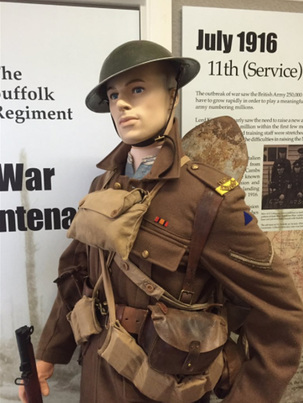
In the latest of a series of continually evolving displays, the centenary figure at the Regimental Museum had changed to a junior NCO of 11th Suffolk; dressed as they were on the first day of the Battle of the Somme.
The figure wears the stopgap leather equipment predominantly issued to the Battalions of the war-raised "new Armies." For the opening attack at La Boiselle on 1st July 1916, men of the Battalion wore two additional bandoliers, two gas helmets (one worn pinned to the shirt, ready to be slipped on instantly), a pick or a shovel and spare bombs in their pockets.
The Battalion were one of the first of the Regiment to wear a series of distinguishing battle patches within their division. Units wore differing coloured strips of cloth tape behind the shoulder titles and different shaped patches on their sleeves.
1st July 1916 started with misty drizzle, but as the Battalion attacked the sun came out and the men saw this as a sign of success. However within minutes, the situation had deteriorated rapidly. 11th Suffolk attained the highest number of casualties that day of any battalion the the 34th Division. Of the 190 men killed, over two-thirds have no known grave and are commemorated on the Thiepval Memorial to the Missing.
(Posted: 26/06/2016)
The figure wears the stopgap leather equipment predominantly issued to the Battalions of the war-raised "new Armies." For the opening attack at La Boiselle on 1st July 1916, men of the Battalion wore two additional bandoliers, two gas helmets (one worn pinned to the shirt, ready to be slipped on instantly), a pick or a shovel and spare bombs in their pockets.
The Battalion were one of the first of the Regiment to wear a series of distinguishing battle patches within their division. Units wore differing coloured strips of cloth tape behind the shoulder titles and different shaped patches on their sleeves.
1st July 1916 started with misty drizzle, but as the Battalion attacked the sun came out and the men saw this as a sign of success. However within minutes, the situation had deteriorated rapidly. 11th Suffolk attained the highest number of casualties that day of any battalion the the 34th Division. Of the 190 men killed, over two-thirds have no known grave and are commemorated on the Thiepval Memorial to the Missing.
(Posted: 26/06/2016)
Now, There's Something You Don't See Every Day!
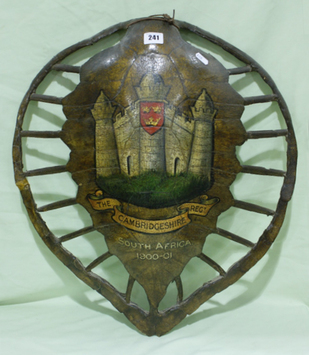
Today, a friend drew our attention to a rather unusual Regimental souvenir that has recently been sold at auction.
This curiously painted turtle's shell is finely decorated with the badge of the Cambridgeshire Regiment. It bears also, their first Battle Honour of "South Africa 1900-01" earned by the men of the Volunteers Battalion's of the Suffolk Regiment for their service in the Boer War.
What's puzzling is that we can't find any reason why a turtle's shell should be adorned in such away. Turtles do live around the Cape of South Africa so maybe it was a sporting trophy from this time. The Cambridgeshire Regiment was not formed until 1908, so it could be an inter-war item, perhaps decorated for a retired officer to adorn his study wall.
Its a real curiosity, so any help you could give us in piecing together its history would be much appreciated.
(Posted: 24/06/2016)
This curiously painted turtle's shell is finely decorated with the badge of the Cambridgeshire Regiment. It bears also, their first Battle Honour of "South Africa 1900-01" earned by the men of the Volunteers Battalion's of the Suffolk Regiment for their service in the Boer War.
What's puzzling is that we can't find any reason why a turtle's shell should be adorned in such away. Turtles do live around the Cape of South Africa so maybe it was a sporting trophy from this time. The Cambridgeshire Regiment was not formed until 1908, so it could be an inter-war item, perhaps decorated for a retired officer to adorn his study wall.
Its a real curiosity, so any help you could give us in piecing together its history would be much appreciated.
(Posted: 24/06/2016)
A Rare CANLOAN Survivor
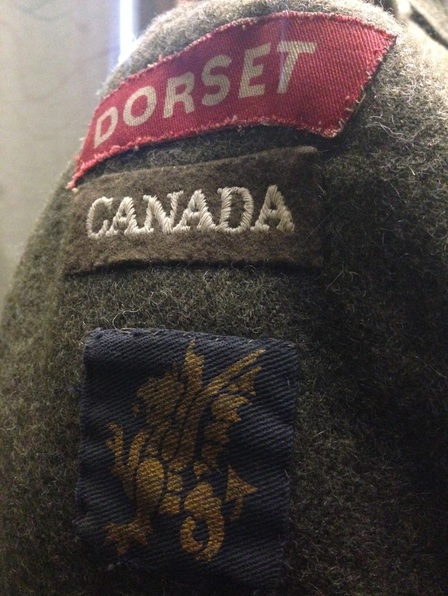
On a recent visit to the Regimental Museum of the Devon and Dorsetshire Regiment's, we were amazed to see a rare surviving battledress blouse of the NW Europe campaign belonging to a "CANLOAN" officer.
CANLOAN meaning "CANadian on LOAN" was a scheme devised in late 1942 to arrange a transfer scheme of Canadian Officers to serve in British infantry Battalions. The British Army was suffering a manpower crisis in 1942, and what it lacked most of all, was skilled officers. The Canadian Army had plenty of officers keen to get involved, and so a transfer was arranged.
1/Suffolk had five Canadian officers during the NW Europe campaign; Captain Ralph Brown, who distinguished himself at the battle for the Chateau de la Londe, Lieutenant John Buchanan, who was badly wounded at the crossroads on the Vire-Tinchebrai Road, Lieutenant John Midwinter, who arrived and was almost immediately wounded, Lieutenant Jack Ayres, who commanded a platoon of C Company for longer than any other officer and then went with the Battalion to Palestine, and Lieutenant Arthur Lawrence, who arrived in early 1945 and served until VE Day.
All CANLOAN officers were volunteers and still retained their own national uniforms and insignia, but until now, we have struggled for evidence as to exactly what the sleeve insignia combination was. The order were clear that the badges of the unit they were serving with should be displayed, but below these, they were to wear their national patch bearing "Canada."
One surviving 1/Suffolk battledress blouse survives in Canada with the family of the late Captain Ralph Brown, but it was great to see this rare survivor in a truly super museum.
(Posted: 10/06/2016)
CANLOAN meaning "CANadian on LOAN" was a scheme devised in late 1942 to arrange a transfer scheme of Canadian Officers to serve in British infantry Battalions. The British Army was suffering a manpower crisis in 1942, and what it lacked most of all, was skilled officers. The Canadian Army had plenty of officers keen to get involved, and so a transfer was arranged.
1/Suffolk had five Canadian officers during the NW Europe campaign; Captain Ralph Brown, who distinguished himself at the battle for the Chateau de la Londe, Lieutenant John Buchanan, who was badly wounded at the crossroads on the Vire-Tinchebrai Road, Lieutenant John Midwinter, who arrived and was almost immediately wounded, Lieutenant Jack Ayres, who commanded a platoon of C Company for longer than any other officer and then went with the Battalion to Palestine, and Lieutenant Arthur Lawrence, who arrived in early 1945 and served until VE Day.
All CANLOAN officers were volunteers and still retained their own national uniforms and insignia, but until now, we have struggled for evidence as to exactly what the sleeve insignia combination was. The order were clear that the badges of the unit they were serving with should be displayed, but below these, they were to wear their national patch bearing "Canada."
One surviving 1/Suffolk battledress blouse survives in Canada with the family of the late Captain Ralph Brown, but it was great to see this rare survivor in a truly super museum.
(Posted: 10/06/2016)
"Pals" - A Clarification
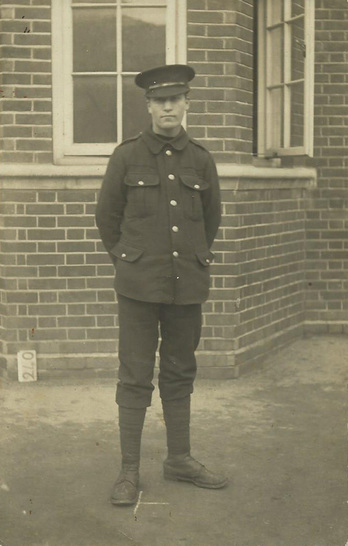
In a few weeks’ time, the nation will remember the centenary of the first day of the Battle of the Somme when in July 1916, no fewer than six Battalions of the Suffolk Regiment and one Battalion of the Cambridgeshire Regiment fought during the five month-long campaign.
For the Suffolk Regiment, the only Battalion that was actively engaged in the attack on the first day, was the 11th (Service) Battalion (Cambridgeshire).
The 11th Battalion was created in September 1914 when a suggestion made by the County's Lord Lieutenant, to raise a Battalion for active service overseas, was approved by the War Office.
In October 2014 as part of our ongoing commemoration of the events of the Great War – Operation Legacy, we chronicled the creation of the Battalion at Bury St. Edmunds from men who had predominantly volunteered in Cambridge and Cambridgeshire and the Isle of Ely.
Through no fault of theirs, these men lived in a recruiting area which had no administrative Depot of it's own. They had instead to travel to their neighbours in Suffolk, whose Regiment had always looked after their training and administrative needs since the earliest days of the volunteer movement.
In the penultimate paragraph of the article, we stated that the Battalion was: “in the loosest sense of the word, a ‘pals’ battalion, with in the early days, an exclusive content from Cambridgeshire.” This is true - for in those early days, their content was predominantly from Cambridgeshire. However since we wrote those words, our statement has been taken up and quoted by, certain people and organisations, to infer that the 11th Battalion was a “Pals” Battalion.
This is simply untrue.
Our meaning of the term “Pals” was as we stated, meant in the loosest possible sense. Early recruits to enlist numbered Cambridge University undergraduates who were all “Pals” or “Chums” who knew each other from their respective colleges. In addition, many old soldiers from the volunteer battalions that had served in South Africa 14 years before, also joined. These men too were "Pals" but also "Old Comrades." Never in Cambridgeshire, did an entire Corporation or Company, join the Battalion en-mass, like in the great industrial towns in the north.
The term “Pals Battalion” has evolved in popular revisionist military history, to infer a Battalion that was predominantly made up from men from a specific geographical area or a specific trade or company. True examples of this include the "Hull Commercials" - made up from predominantly white collar office workers in Hull, the "Sheffield City Battalion" - made up from men who lived in the centre of the city, and perhaps the most famous "Pals" Battalion, the "Grimsby Chums" - made up from men from the town and its immediate locality. Ironically the famous "Accrington Pals" - a name given to the 11th Battalion, East Lancashire Regiment, was completely false. Less than one Company of the 1000-strong Battalion (less than 250 men) actually came from Accrington.
This was also the case of the 11th Battalion, with men coming from far across Cambridgeshire, West Suffolk and even from London - men who, tried unsuccessfully to enlist in London, travelled to the provinces to try again. The myth however, that 11th Suffolk were a “Pals” Battalion, has deeply engrained roots in the local history of Cambridgeshire which predates our article of October 2014.
In November 2013; one year before our piece was published, the Cambs Times published an online article regarding a remembrance event at a local Chatteris school which commented “The children have also stitched together a patchwork commemorating the 11th Battalion, Suffolk Regiment, known as “the Cambridgeshire Pals Battalion”.” and as recent as early 2016, writing on the Imperial War Museum’s website, Matt Brosnan stated “Pals battalions were also raised from Birmingham to Bristol and from Cambridge to Cardiff.” The great, ever factual wikipedia quotes not only the 11th Battalion of the Suffolk Regiment as a "Pals" Battalion, but the 12th and 13th Battalions as well.
To some newer generations of military historians, perhaps a little ignorant of the history of the Battalion and it's former members, this current trend to perpetuate this unsubstantiated myth - to sell a few more books over the period of the centenary, is damaging, disrespectful and unhelpful to our Regimental History.
The 11th Battalion were never at the time given the title of “Pals” nor were they in the proceeding years, ever referred to by that name. There is to the best of our knowledge, no contemporary evidence giving the Battalion this title and certainly of the few surviving veterans we met in the 1980s, none of them ever referred to 11th Suffolk as a “Pals” Battalion. We encourage you to challenge our claim above and find evidence that they were known as a "Pals" Battalion, but with over 60 years combined research, we've not found any evidence yet!
11th Suffolk were the "Cambs Suffolks" and they were mighty proud of it too. They were never the "Cambridgeshire Pals."
(Posted: 07/06/2016)
For the Suffolk Regiment, the only Battalion that was actively engaged in the attack on the first day, was the 11th (Service) Battalion (Cambridgeshire).
The 11th Battalion was created in September 1914 when a suggestion made by the County's Lord Lieutenant, to raise a Battalion for active service overseas, was approved by the War Office.
In October 2014 as part of our ongoing commemoration of the events of the Great War – Operation Legacy, we chronicled the creation of the Battalion at Bury St. Edmunds from men who had predominantly volunteered in Cambridge and Cambridgeshire and the Isle of Ely.
Through no fault of theirs, these men lived in a recruiting area which had no administrative Depot of it's own. They had instead to travel to their neighbours in Suffolk, whose Regiment had always looked after their training and administrative needs since the earliest days of the volunteer movement.
In the penultimate paragraph of the article, we stated that the Battalion was: “in the loosest sense of the word, a ‘pals’ battalion, with in the early days, an exclusive content from Cambridgeshire.” This is true - for in those early days, their content was predominantly from Cambridgeshire. However since we wrote those words, our statement has been taken up and quoted by, certain people and organisations, to infer that the 11th Battalion was a “Pals” Battalion.
This is simply untrue.
Our meaning of the term “Pals” was as we stated, meant in the loosest possible sense. Early recruits to enlist numbered Cambridge University undergraduates who were all “Pals” or “Chums” who knew each other from their respective colleges. In addition, many old soldiers from the volunteer battalions that had served in South Africa 14 years before, also joined. These men too were "Pals" but also "Old Comrades." Never in Cambridgeshire, did an entire Corporation or Company, join the Battalion en-mass, like in the great industrial towns in the north.
The term “Pals Battalion” has evolved in popular revisionist military history, to infer a Battalion that was predominantly made up from men from a specific geographical area or a specific trade or company. True examples of this include the "Hull Commercials" - made up from predominantly white collar office workers in Hull, the "Sheffield City Battalion" - made up from men who lived in the centre of the city, and perhaps the most famous "Pals" Battalion, the "Grimsby Chums" - made up from men from the town and its immediate locality. Ironically the famous "Accrington Pals" - a name given to the 11th Battalion, East Lancashire Regiment, was completely false. Less than one Company of the 1000-strong Battalion (less than 250 men) actually came from Accrington.
This was also the case of the 11th Battalion, with men coming from far across Cambridgeshire, West Suffolk and even from London - men who, tried unsuccessfully to enlist in London, travelled to the provinces to try again. The myth however, that 11th Suffolk were a “Pals” Battalion, has deeply engrained roots in the local history of Cambridgeshire which predates our article of October 2014.
In November 2013; one year before our piece was published, the Cambs Times published an online article regarding a remembrance event at a local Chatteris school which commented “The children have also stitched together a patchwork commemorating the 11th Battalion, Suffolk Regiment, known as “the Cambridgeshire Pals Battalion”.” and as recent as early 2016, writing on the Imperial War Museum’s website, Matt Brosnan stated “Pals battalions were also raised from Birmingham to Bristol and from Cambridge to Cardiff.” The great, ever factual wikipedia quotes not only the 11th Battalion of the Suffolk Regiment as a "Pals" Battalion, but the 12th and 13th Battalions as well.
To some newer generations of military historians, perhaps a little ignorant of the history of the Battalion and it's former members, this current trend to perpetuate this unsubstantiated myth - to sell a few more books over the period of the centenary, is damaging, disrespectful and unhelpful to our Regimental History.
The 11th Battalion were never at the time given the title of “Pals” nor were they in the proceeding years, ever referred to by that name. There is to the best of our knowledge, no contemporary evidence giving the Battalion this title and certainly of the few surviving veterans we met in the 1980s, none of them ever referred to 11th Suffolk as a “Pals” Battalion. We encourage you to challenge our claim above and find evidence that they were known as a "Pals" Battalion, but with over 60 years combined research, we've not found any evidence yet!
11th Suffolk were the "Cambs Suffolks" and they were mighty proud of it too. They were never the "Cambridgeshire Pals."
(Posted: 07/06/2016)
CWGC Launch 'Thiepval' App
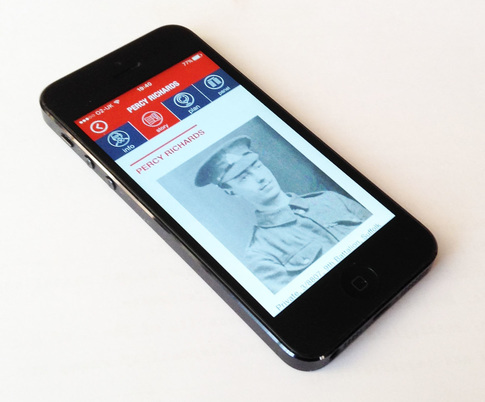
This week, the Commonwealth War Graves Commission launched their centenary 'Thiepval' App.
For those of you who have the technology, its well worth downloading for it details the 1091 Suffolk Regiment casualties of the Battle of the Somme that fell in action, but who have no known grave and are commemorated on the Memorial to the Missing at Thiepval.
The app has a special section "the 600" with individual biographies of some of those on the memorial. At present a quick search had found almost 10 Suffolks and their histories, but there are most probably many more.
One notable biography is Lieutenant Geoffrey Henry Cadwallander Adams; a notable minor poet of the war who was killed with A Company of 4th Suffolk in the Battalion attack on "Dewdrop" trench near Lesboefs on 1st November 1916.
Oh, by the way, it's free to download!
(Posted: 04/06/2016)
For those of you who have the technology, its well worth downloading for it details the 1091 Suffolk Regiment casualties of the Battle of the Somme that fell in action, but who have no known grave and are commemorated on the Memorial to the Missing at Thiepval.
The app has a special section "the 600" with individual biographies of some of those on the memorial. At present a quick search had found almost 10 Suffolks and their histories, but there are most probably many more.
One notable biography is Lieutenant Geoffrey Henry Cadwallander Adams; a notable minor poet of the war who was killed with A Company of 4th Suffolk in the Battalion attack on "Dewdrop" trench near Lesboefs on 1st November 1916.
Oh, by the way, it's free to download!
(Posted: 04/06/2016)
A Few Running Repairs
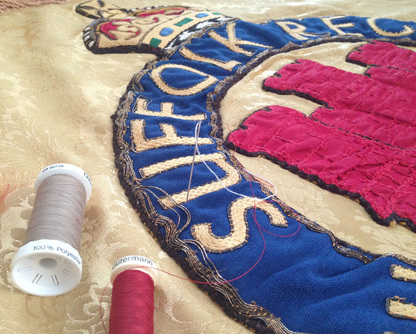
Tomorrow, the Friends have a solum and sad undertaking - to attend the funeral of Tony Rogers; the man who saved the Suffolk Regiment.
Tony was a great man and was fiercely proud of his service in The Suffolk Regiment. It was due to him that the Hemel Hempstead Branch of the Old Comrades Association became the biggest branch of the OCA with over 400 members worldwide. It was also due to Tony that the Suffolk Regiment was kept alive when many others thought it dead.
The Ipswich Branch Standard; the oldest in the Old Comrades Association, will be in attendance tomorrow, but at youthful 66 years young, she needs a few running repairs from time-to-time. Like the 106 year-old Colours of the 1st Battalion, the Standard has had periodical repairs during the course of its life. Sadly however with the lack of a Tailors Shop or the Pioneer Sergeants needle to perform the repairs, we have had to effect a few stitches ourselves to ensure it's in perfect condition tomorrow.
The original needlework was performed by Mrs Overman; the wife of the late CSM Francis Overman, who came from Ipswich, but was killed in Normandy on 12th June 1944, whilst serving with the 1st Battalion. Mrs Overman, an expert embroiderer, taught at the Ipswich School of Needlework and completed the Standard to an approved design in 1950.
Farewell old chum, we can never thank you enough for keeping the 'Old Dozen' alive.
(Posted: 23/05/2016)
Tony was a great man and was fiercely proud of his service in The Suffolk Regiment. It was due to him that the Hemel Hempstead Branch of the Old Comrades Association became the biggest branch of the OCA with over 400 members worldwide. It was also due to Tony that the Suffolk Regiment was kept alive when many others thought it dead.
The Ipswich Branch Standard; the oldest in the Old Comrades Association, will be in attendance tomorrow, but at youthful 66 years young, she needs a few running repairs from time-to-time. Like the 106 year-old Colours of the 1st Battalion, the Standard has had periodical repairs during the course of its life. Sadly however with the lack of a Tailors Shop or the Pioneer Sergeants needle to perform the repairs, we have had to effect a few stitches ourselves to ensure it's in perfect condition tomorrow.
The original needlework was performed by Mrs Overman; the wife of the late CSM Francis Overman, who came from Ipswich, but was killed in Normandy on 12th June 1944, whilst serving with the 1st Battalion. Mrs Overman, an expert embroiderer, taught at the Ipswich School of Needlework and completed the Standard to an approved design in 1950.
Farewell old chum, we can never thank you enough for keeping the 'Old Dozen' alive.
(Posted: 23/05/2016)
Tony Rogers;
The Man Who Saved The Suffolk Regiment
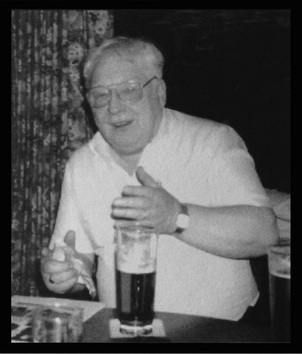
It is with profound sadness that we report the loss of a very special Suffolk Regiment soldier, Tony Rogers.
Of Tony it can be said, that he was personally responsible for ensuring the survival of The Suffolk Regiment.
In an age before the Friends came into existence, it was due to the personal efforts of Tony, that every known Suffolk soldier was sought out and made to join the Hemel Hempstead Branch of the Old Comrades Association. It was an amazing tribute to Tony's enthusiasm and forcefulness that the branch, which had only been in existence since the late 1980s, was within 15 years, the largest ever branch of OCA, with over 400 members in ever corner of the world.
Tony was, unlike many of his contemporaries, prepared to embrace technology. In an increasingly advancing world, he realised that the Internet and email were the tools that would keep the Regiment alive. As Branch funds increased through a larger membership, he took to producing a fantastic little newsletter that was published twice a year for the membership.
Tony was also quick to realise early-on that the survival and future of the Suffolk Regiment lay with the next generation. He actively encouraged sons and daughters, grandchildren and great grandchildren to join and contribute to his publications; an ethos that the Friends adopted from him and which we still retain to this day.
Tony was always at Minden Day, the annual Malaya veterans Pig Roast; held by his old chum, John Blench, and the Diss Malaya veterans luncheons. Always on hand with trademark camera and tripod, he recorded the antics and adventures of his comrades, just as he had done 50 years before in Malaya.
Tony had battled with ill health for some time, but still managed for over six years to produce his magazine to an exceptionally high standard receiving much acclaim. When other OCA branches were dwindling, Tony continued to keep the Hemel Branch alive. In 2005 he along with fellow Malaya veteran, Ray Burdette, secured a substantial Heritage Lottery grant to celebrate the 60th anniversary of the end of World War Two. The grant paid for the publication of a dedicated book of veterans memoirs and more importantly, for the Band of the Irish Guards to play at the Minden Day reunion. It was a splendid day for him and for all the Regiment for not since 1985; when the Regiment celebrated its tricentenary, had a complete marching band played at the event.
When his poor health got the better of him, Tony reluctantly stopped producing the magazines and instead went to a simpler email newsletter. Tony's service to his country as a young National Serviceman in Malaya may have been all but two years in duration, but for the next 60 years, he did more for the Regiment than anyone else we know.
Without Tony, the 'Old Dozen' would have disappeared to history many years ago. It was he who fought valiantly to keep it alive, when many others thought it dead, and it was he personally who rekindled the flames of comradeship through his newsletters. It was he that laid the foundation for the Friends.
We should remember him like a protestor with a megaphone; determined to let everyone know that the Suffolk Regiment was still here and it wasn't going to go away. He cared passionately about the Regiment and all who served it and for him, the support and benevolence of his former members was always, his highest priority.
Tony was a true statesman and champion for the Suffolk Regiment soldier. We shall not see his like again.
(Originally Posted: 12/05/2016)
Of Tony it can be said, that he was personally responsible for ensuring the survival of The Suffolk Regiment.
In an age before the Friends came into existence, it was due to the personal efforts of Tony, that every known Suffolk soldier was sought out and made to join the Hemel Hempstead Branch of the Old Comrades Association. It was an amazing tribute to Tony's enthusiasm and forcefulness that the branch, which had only been in existence since the late 1980s, was within 15 years, the largest ever branch of OCA, with over 400 members in ever corner of the world.
Tony was, unlike many of his contemporaries, prepared to embrace technology. In an increasingly advancing world, he realised that the Internet and email were the tools that would keep the Regiment alive. As Branch funds increased through a larger membership, he took to producing a fantastic little newsletter that was published twice a year for the membership.
Tony was also quick to realise early-on that the survival and future of the Suffolk Regiment lay with the next generation. He actively encouraged sons and daughters, grandchildren and great grandchildren to join and contribute to his publications; an ethos that the Friends adopted from him and which we still retain to this day.
Tony was always at Minden Day, the annual Malaya veterans Pig Roast; held by his old chum, John Blench, and the Diss Malaya veterans luncheons. Always on hand with trademark camera and tripod, he recorded the antics and adventures of his comrades, just as he had done 50 years before in Malaya.
Tony had battled with ill health for some time, but still managed for over six years to produce his magazine to an exceptionally high standard receiving much acclaim. When other OCA branches were dwindling, Tony continued to keep the Hemel Branch alive. In 2005 he along with fellow Malaya veteran, Ray Burdette, secured a substantial Heritage Lottery grant to celebrate the 60th anniversary of the end of World War Two. The grant paid for the publication of a dedicated book of veterans memoirs and more importantly, for the Band of the Irish Guards to play at the Minden Day reunion. It was a splendid day for him and for all the Regiment for not since 1985; when the Regiment celebrated its tricentenary, had a complete marching band played at the event.
When his poor health got the better of him, Tony reluctantly stopped producing the magazines and instead went to a simpler email newsletter. Tony's service to his country as a young National Serviceman in Malaya may have been all but two years in duration, but for the next 60 years, he did more for the Regiment than anyone else we know.
Without Tony, the 'Old Dozen' would have disappeared to history many years ago. It was he who fought valiantly to keep it alive, when many others thought it dead, and it was he personally who rekindled the flames of comradeship through his newsletters. It was he that laid the foundation for the Friends.
We should remember him like a protestor with a megaphone; determined to let everyone know that the Suffolk Regiment was still here and it wasn't going to go away. He cared passionately about the Regiment and all who served it and for him, the support and benevolence of his former members was always, his highest priority.
Tony was a true statesman and champion for the Suffolk Regiment soldier. We shall not see his like again.
(Originally Posted: 12/05/2016)
The Loss Of An Ipswich Rugby Legend and Suffolk Regiment NS Officer
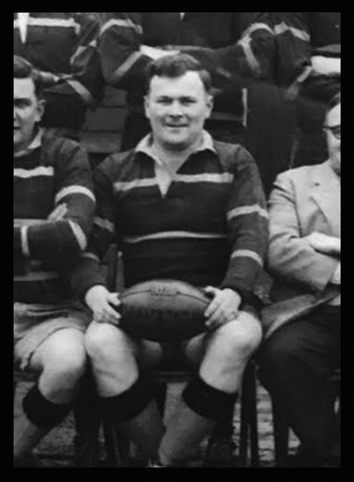
Today, the Friends learnt of the passing of rugby legend, Jim Sanders, who was one of Ipswich's best known rugby players of the 1950's and 60's.
James Stuart Saunders was commissioned into the Suffolk Regiment on 28th January 1956, and joined the 1st Battalion at Colchester shortly afterwards. Within weeks, they were preparing for the visit of the Colonel-in-Chief; H.R.H. The Princess Margaret, who was to visit them at Roman Way Camp before they departed for their last overseas posting to Cyprus.
His career with the Suffolk Regiment was to be a comparatively short one, for within 18 months, he would be home and returning to civilian life. He was promoted to Lieutenant on 5th July 1957, and was transferred to the list of Reserve Officers for the 4th Battalion (Territorial Army).
Educated at Ipswich School, Jim Saunders joined Ipswich Rugby Club in 1957 after the completion of his National Service. He won 47 consecutive caps for Eastern Counties between 1958 and 1966 whilst captain of the side; a record that is unlikely ever to be beaten in the clubs history.
Described as "the finest prop who could definitely have played at a higher level," he later turned down the opportunity to play first class rugby with Harlequins because he felt he would have more fun playing with Ipswich.
Saunders was one of three brothers who were to play rugby in Ipswich. His older brother, the late 'Sandy' Sanders, who began his rugby career at Ipswich YMCA, went on to play for Harlequins and England and was president of the Rugby Football Union. Derek Sanders, the youngest and last surviving brother, also played for Ipswich, Eastern Counties and Harlequins.
With grateful thanks to Friend Bob West for supplying this information.
(Posted: 30/04/2016)
James Stuart Saunders was commissioned into the Suffolk Regiment on 28th January 1956, and joined the 1st Battalion at Colchester shortly afterwards. Within weeks, they were preparing for the visit of the Colonel-in-Chief; H.R.H. The Princess Margaret, who was to visit them at Roman Way Camp before they departed for their last overseas posting to Cyprus.
His career with the Suffolk Regiment was to be a comparatively short one, for within 18 months, he would be home and returning to civilian life. He was promoted to Lieutenant on 5th July 1957, and was transferred to the list of Reserve Officers for the 4th Battalion (Territorial Army).
Educated at Ipswich School, Jim Saunders joined Ipswich Rugby Club in 1957 after the completion of his National Service. He won 47 consecutive caps for Eastern Counties between 1958 and 1966 whilst captain of the side; a record that is unlikely ever to be beaten in the clubs history.
Described as "the finest prop who could definitely have played at a higher level," he later turned down the opportunity to play first class rugby with Harlequins because he felt he would have more fun playing with Ipswich.
Saunders was one of three brothers who were to play rugby in Ipswich. His older brother, the late 'Sandy' Sanders, who began his rugby career at Ipswich YMCA, went on to play for Harlequins and England and was president of the Rugby Football Union. Derek Sanders, the youngest and last surviving brother, also played for Ipswich, Eastern Counties and Harlequins.
With grateful thanks to Friend Bob West for supplying this information.
(Posted: 30/04/2016)
Happy Birthday Ma'am
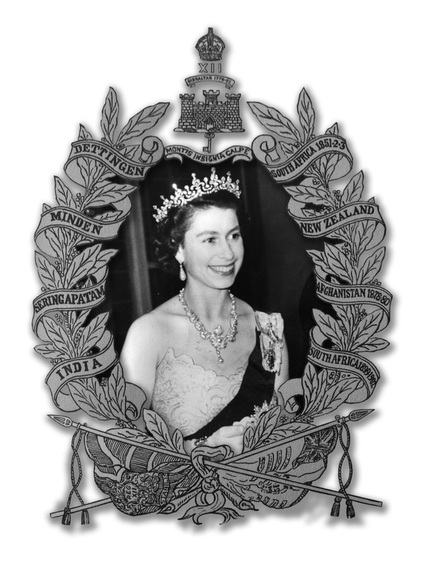
The Friends send Her Majesty, Queen Elizabeth, our most sincerest wishes on this, her 90th Birthday.
The longest reigning British Monarch, her life has seen a World War in which she served her country, the end of Empire and the birth of the Commonwealth. Though her own family has gone through difficult times in a changing age, her dedication to this country and it's people has never faltered.
When she ascended to the throne in 1952, The Suffolk Regiment were serving in Malaya. Within two years, they would be posted to Germany; on the front line against a soviet attack and anticipated Cold War, and later, they would end their days in Cyprus in the final days of Empire.
Under her reign, The Suffolk Regiment marched into history. For just eight years, they proudly served her until, successive defence cuts saw their inevitable amalgamation.
Today, their successors still wear roses in their headdress; a tradition that dates back to the Battle of Dettingen when King George II, placed himself at the head of the old 12th of Foot and led them into battle. Whenever the monarch is present, roses are worn in honour of the occasion.
We wish Her Majesty many happy returns on reaching such an historic milestone and look forward to her continued leadership of this great land for many more years to come.
(Posted: 21/04/2016)
The longest reigning British Monarch, her life has seen a World War in which she served her country, the end of Empire and the birth of the Commonwealth. Though her own family has gone through difficult times in a changing age, her dedication to this country and it's people has never faltered.
When she ascended to the throne in 1952, The Suffolk Regiment were serving in Malaya. Within two years, they would be posted to Germany; on the front line against a soviet attack and anticipated Cold War, and later, they would end their days in Cyprus in the final days of Empire.
Under her reign, The Suffolk Regiment marched into history. For just eight years, they proudly served her until, successive defence cuts saw their inevitable amalgamation.
Today, their successors still wear roses in their headdress; a tradition that dates back to the Battle of Dettingen when King George II, placed himself at the head of the old 12th of Foot and led them into battle. Whenever the monarch is present, roses are worn in honour of the occasion.
We wish Her Majesty many happy returns on reaching such an historic milestone and look forward to her continued leadership of this great land for many more years to come.
(Posted: 21/04/2016)
The Birth Of A Regiment
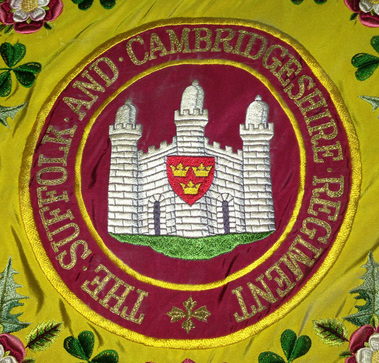
On April 4th 1961, The Suffolk Regiment finally ceased to exist.
The Regular 1st Battalion had already two years before, amalgamated with their neighbours in Norfolk to create the 1/1st East Anglian Regiment, but despite this, the 4th (Territorial) Battalion, remained as a separate entity; affiliated to the regular battalion, yet retaining it's original designation of "The Suffolk Regiment"
With the end of National Service, the need to keep former National Servicemen on the Reserve List and make them attend three years of TA training, ceased. With the influx of these men gone, the TA suffered the first of a series of reshuffles and downgrades that would see the disappearance of many of county TA battalions, most being merged or disbanded.
For the 4th Battalion, they were to be merged with their cousins in Cambridgeshire. Though they had started as a partnership in the days of the rifle volunteers before the Great War, they had separated under the Haldane reforms of 1908, Now, after 53 years service, they were being merged once more in the twilight of their long and honourable lives.
The new "Suffolk and Cambridgeshire Regiment (TA)" was formed in April 1961 and brought together two proud Battalions for six years further service throughout the 1960s. The union was a happy one, creating a great band and an effective unit, that continually supplemented the regular 1st East Anglian Regiment abroad on campaign in Aden and Radfan. By 1967, a further reorganisation of the Territorial Army, saw them reduced to a cadre and then finally disbanded.
On the 55th anniversary of their creation, we remember the humble "ever-ready's" who were prepared to defend this country against a nuclear attack at the height of the cold war.
(Posted: 04/04/2016)
The Regular 1st Battalion had already two years before, amalgamated with their neighbours in Norfolk to create the 1/1st East Anglian Regiment, but despite this, the 4th (Territorial) Battalion, remained as a separate entity; affiliated to the regular battalion, yet retaining it's original designation of "The Suffolk Regiment"
With the end of National Service, the need to keep former National Servicemen on the Reserve List and make them attend three years of TA training, ceased. With the influx of these men gone, the TA suffered the first of a series of reshuffles and downgrades that would see the disappearance of many of county TA battalions, most being merged or disbanded.
For the 4th Battalion, they were to be merged with their cousins in Cambridgeshire. Though they had started as a partnership in the days of the rifle volunteers before the Great War, they had separated under the Haldane reforms of 1908, Now, after 53 years service, they were being merged once more in the twilight of their long and honourable lives.
The new "Suffolk and Cambridgeshire Regiment (TA)" was formed in April 1961 and brought together two proud Battalions for six years further service throughout the 1960s. The union was a happy one, creating a great band and an effective unit, that continually supplemented the regular 1st East Anglian Regiment abroad on campaign in Aden and Radfan. By 1967, a further reorganisation of the Territorial Army, saw them reduced to a cadre and then finally disbanded.
On the 55th anniversary of their creation, we remember the humble "ever-ready's" who were prepared to defend this country against a nuclear attack at the height of the cold war.
(Posted: 04/04/2016)
Another Great Daffodil Sunday
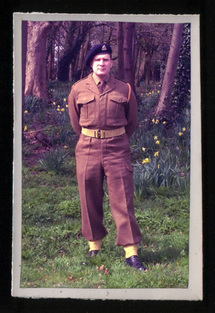
Today, the Suffolk Regiment Museum opened its doors once more to celebrate “Daffodil Sunday” with many visitors flocking to visit the museum and views it’s many amazing treasures.
“Daffodil Sunday” was traditionally the day when once a year, The Suffolk Regiment opened the gates of its Depot to the public, inviting them to come and see how their county regiment operated. At is height in the 1950s, thousands of people came along to see The Suffolk Regiment in action and visit the embryonic Regimental Museum that had been started in one of the buildings on the barrack site.
This year the neighbouring woods; which were once part of the barracks site, were once again, awash with bright yellow daffodils; some of the bulbs it is rumoured, date back almost 100 years.
Visitors were treated to guided walks throughout the day, touring the former locations of the barrack buildings and seeing some of the surviving archaeology that remains of the old barrack site. A display of military vehicles was organised by the Suffolk Branch of the Military Vehicle Trust. Next year will be even better!
(Posted: 03/04/2016)
“Daffodil Sunday” was traditionally the day when once a year, The Suffolk Regiment opened the gates of its Depot to the public, inviting them to come and see how their county regiment operated. At is height in the 1950s, thousands of people came along to see The Suffolk Regiment in action and visit the embryonic Regimental Museum that had been started in one of the buildings on the barrack site.
This year the neighbouring woods; which were once part of the barracks site, were once again, awash with bright yellow daffodils; some of the bulbs it is rumoured, date back almost 100 years.
Visitors were treated to guided walks throughout the day, touring the former locations of the barrack buildings and seeing some of the surviving archaeology that remains of the old barrack site. A display of military vehicles was organised by the Suffolk Branch of the Military Vehicle Trust. Next year will be even better!
(Posted: 03/04/2016)
Just Like Busses!
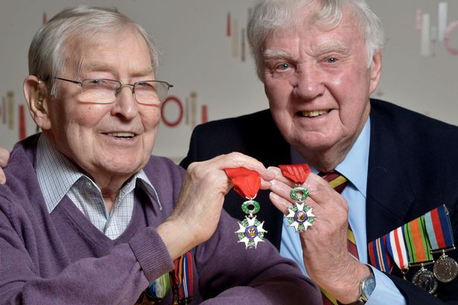
The Suffolk Regiment is like busses. For years it will totter on without ever touching the headlines, but over the last few weeks, it's been back at the top of the new sheets again with yet another Suffolk D-Day soldier being plucked from retirement to receive the Legion d'Honneur.
This time news came from Friends in Manchester that Ken Wright, formerly of 1/Sufffolk, had received France's highest honour. Ken, a rifleman in 'A' Company was one of those who landed on D-Day and went on to capture the highly fortified enemy position codenamed "Hillman" on the afternoon of D-Day. Ken was a crack shot and as the Company advanced through the village of Colleville, he was tasked to pick out any snipers that remained. He continued to serve with 1/Suffolk throughout North-West Europe, being one of those who came through the campaign without being wounded. He went with he Battalion to Palestine where he was demobbed.
Ken received his medal at the same time that his brother-in-law, Fred Barrett did. The two men married two sisters after the war had ended. We're chuffed that in this centenary year of the anniversary of the battle of the Somme, where the media has gone all-out on a remembering poets and the pals, that the battles of the Second World War are being remembered too.
(Posted: 20/03/2016)
This time news came from Friends in Manchester that Ken Wright, formerly of 1/Sufffolk, had received France's highest honour. Ken, a rifleman in 'A' Company was one of those who landed on D-Day and went on to capture the highly fortified enemy position codenamed "Hillman" on the afternoon of D-Day. Ken was a crack shot and as the Company advanced through the village of Colleville, he was tasked to pick out any snipers that remained. He continued to serve with 1/Suffolk throughout North-West Europe, being one of those who came through the campaign without being wounded. He went with he Battalion to Palestine where he was demobbed.
Ken received his medal at the same time that his brother-in-law, Fred Barrett did. The two men married two sisters after the war had ended. We're chuffed that in this centenary year of the anniversary of the battle of the Somme, where the media has gone all-out on a remembering poets and the pals, that the battles of the Second World War are being remembered too.
(Posted: 20/03/2016)
Spiky Suffolk Hats
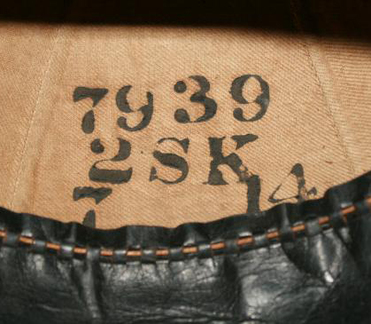
Recently, an example of a pre-Great War Suffolk Home Service Helmet was sold by a well-known militaria dealer.
The helmet, belonging to 7939 Private E.J. Brown, conformed to the standard pattern with brass spike and chinstrap with patent leather edge, but sadly missed its helmet plate.
Brown joined 2nd Suffolk in February 1910 and would have almost certainly been with the Battalion when they were called out for civil duties at Chirk colliery in 1912 and, when the Army revolted at the Curragh in March 1914; occasions at which the Home Service helmet was worn.
The stencilled date in the helmet puts its issue at July 1914; a month before the Battalion were mobilised for war; proof that as late as the middle of 1914, these helmets were still being worn.
Private John Brown went with the Battalion to France in August of 1914 and survived the Battalion's gallant stand at Le Cateau on 26th August. He was most likely wounded in late February 1915 when the Battalion were in the front line between Vierstraat and La Clytte. He would have been taken from here to an advanced dressing station and from there to the Base Hospital at Boulogne, from where he must have sadly died of his injuries on 6th March 1915. A rare survivor, Brown's helmet is a great and poignant reminder of the last ceremonial days of 2nd Suffolk before war came and changed the British Army forever.
(Posted: 09/03/2016)
The helmet, belonging to 7939 Private E.J. Brown, conformed to the standard pattern with brass spike and chinstrap with patent leather edge, but sadly missed its helmet plate.
Brown joined 2nd Suffolk in February 1910 and would have almost certainly been with the Battalion when they were called out for civil duties at Chirk colliery in 1912 and, when the Army revolted at the Curragh in March 1914; occasions at which the Home Service helmet was worn.
The stencilled date in the helmet puts its issue at July 1914; a month before the Battalion were mobilised for war; proof that as late as the middle of 1914, these helmets were still being worn.
Private John Brown went with the Battalion to France in August of 1914 and survived the Battalion's gallant stand at Le Cateau on 26th August. He was most likely wounded in late February 1915 when the Battalion were in the front line between Vierstraat and La Clytte. He would have been taken from here to an advanced dressing station and from there to the Base Hospital at Boulogne, from where he must have sadly died of his injuries on 6th March 1915. A rare survivor, Brown's helmet is a great and poignant reminder of the last ceremonial days of 2nd Suffolk before war came and changed the British Army forever.
(Posted: 09/03/2016)
The Only Man From The Village To Die In The Great War
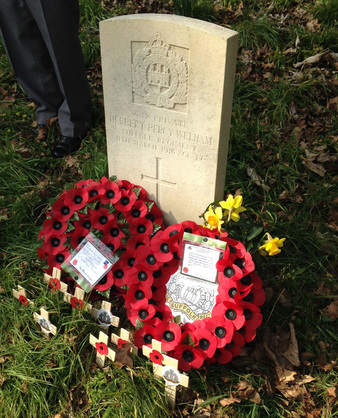
Today, a small but impressive ceremony was held in Little Blakenham churchyard to celebrate the 100th anniversary of the only member of the village to fall in the Great War; Private Herbert Percy Welham.
Herbert joined the 3/4th Battalion of The Suffolk Regiment in 1915 when he was only 17 years old and was soon with them in Camp at Halton, near Tring in Hertfordshire. The 3/4th Battalion were the Reserve Battalion of 4th Suffolk and were then under the temporary command of Major F.W. Turner, who was soon to return to the 1/4th Battalion in France, where he would take over it's command.
Born in the nearby village of Somersham, Herbert lived in the quaintly named “Leather Bottle Hill” in Little Blakenham when war was declared in 1914. Though under age, he already had two brothers serving with 1/4th Suffolk in France and he was keen, as soon as he could, to join them.
The Reserve Battalion were training hard at Halton, ready to be sent to France in the forthcoming months. It was whilst training that Herbert was taken ill with double pneumonia, which in turn, led to his dying from pericarditis in Aylesbury Military Hospital on 11th March 1916.
His body was brought home to Suffolk with six members of his Battalion carrying his coffin, covered in wreaths from the family and the Regiment. A volley was fired at the graveside and the Last Post was sounded. The churchyard it was reported “was filled with a large gathering of sympathetic friends.”
Fittingly, at today’s service, both the Standard Bearers in attendance were former members of the 4th Battalion, having served in the post war years. Herbert Welham is not forgotten by his family or the village in which he lived. One hundred years on, two members of his family, who still live in Suffolk, came to remember a family member they never knew.
(Posted: 11/03/2016)
Herbert joined the 3/4th Battalion of The Suffolk Regiment in 1915 when he was only 17 years old and was soon with them in Camp at Halton, near Tring in Hertfordshire. The 3/4th Battalion were the Reserve Battalion of 4th Suffolk and were then under the temporary command of Major F.W. Turner, who was soon to return to the 1/4th Battalion in France, where he would take over it's command.
Born in the nearby village of Somersham, Herbert lived in the quaintly named “Leather Bottle Hill” in Little Blakenham when war was declared in 1914. Though under age, he already had two brothers serving with 1/4th Suffolk in France and he was keen, as soon as he could, to join them.
The Reserve Battalion were training hard at Halton, ready to be sent to France in the forthcoming months. It was whilst training that Herbert was taken ill with double pneumonia, which in turn, led to his dying from pericarditis in Aylesbury Military Hospital on 11th March 1916.
His body was brought home to Suffolk with six members of his Battalion carrying his coffin, covered in wreaths from the family and the Regiment. A volley was fired at the graveside and the Last Post was sounded. The churchyard it was reported “was filled with a large gathering of sympathetic friends.”
Fittingly, at today’s service, both the Standard Bearers in attendance were former members of the 4th Battalion, having served in the post war years. Herbert Welham is not forgotten by his family or the village in which he lived. One hundred years on, two members of his family, who still live in Suffolk, came to remember a family member they never knew.
(Posted: 11/03/2016)
Untouched History
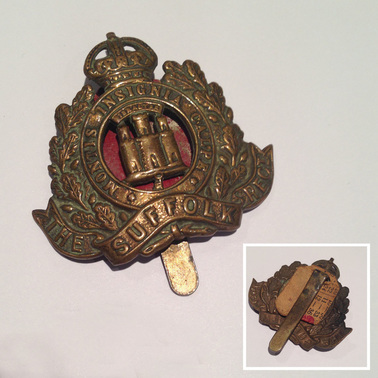
It is regrettable perhaps for a younger generation of collectors that nearly every different variant of Suffolk Regiment cap has now been reproduced. Everything from Victorian, to the Volunteer Battalions, to the anodised final pattern have all been copied.
The most common variety to be faked has always been the all brass "War Service" badge of the Great War, known colloquially now as the 'economy pattern' - a term which was never used at the time.
There are literally thousands on offer today, including some very good toned and artificially aged examples; designed deliberately to mislead the buyer.
However, today in the post arrived a genuine war service badge that we'd spotted on eBay, that came complete with its original red backing behind the castle and key.
Upon closer inspection, the red backing was not felt as is normally found, but a piece of red card, cut from the cover of a copy of "Musketry Regulations" showing on the rear, the different editions publication dates for the precision revisions from inside the front cover.
It's nice to see a genuine war service badge amongst all the fakes and forgeries out there, especially one that has remained untouched for 100 years.
(Posted:05/03/2016)
The most common variety to be faked has always been the all brass "War Service" badge of the Great War, known colloquially now as the 'economy pattern' - a term which was never used at the time.
There are literally thousands on offer today, including some very good toned and artificially aged examples; designed deliberately to mislead the buyer.
However, today in the post arrived a genuine war service badge that we'd spotted on eBay, that came complete with its original red backing behind the castle and key.
Upon closer inspection, the red backing was not felt as is normally found, but a piece of red card, cut from the cover of a copy of "Musketry Regulations" showing on the rear, the different editions publication dates for the precision revisions from inside the front cover.
It's nice to see a genuine war service badge amongst all the fakes and forgeries out there, especially one that has remained untouched for 100 years.
(Posted:05/03/2016)
Happy In A New Home
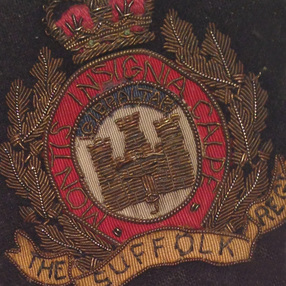
Last month, we brought you the news that the Leiston Branch of the Old Comrades Association had been forced to vacate their home for many years. We thought that the Branch's existence may have hung in the balance, but happily the fighting spirit of the Suffolk soldier has once again shone through.
At their first meeting in their new location, they had a record turnout of old Suffolks and their partners and they seem to have settled in well in their new home. The Branch is definitely set to continue for many more years to come.
Perhaps it was history shining over them, for exactly 100 years to the day that their meeting was held, 2nd Suffolk had just taken the Bluff; an action that gained for them six Military Crosses, five Distinguished Conduct Medals and countless Mentions-in-Dispatches.
The fighting spirit of The Suffolk Regiment still lives on in East Suffolk!
(Posted: 02/03/2016)
At their first meeting in their new location, they had a record turnout of old Suffolks and their partners and they seem to have settled in well in their new home. The Branch is definitely set to continue for many more years to come.
Perhaps it was history shining over them, for exactly 100 years to the day that their meeting was held, 2nd Suffolk had just taken the Bluff; an action that gained for them six Military Crosses, five Distinguished Conduct Medals and countless Mentions-in-Dispatches.
The fighting spirit of The Suffolk Regiment still lives on in East Suffolk!
(Posted: 02/03/2016)
Sad Times
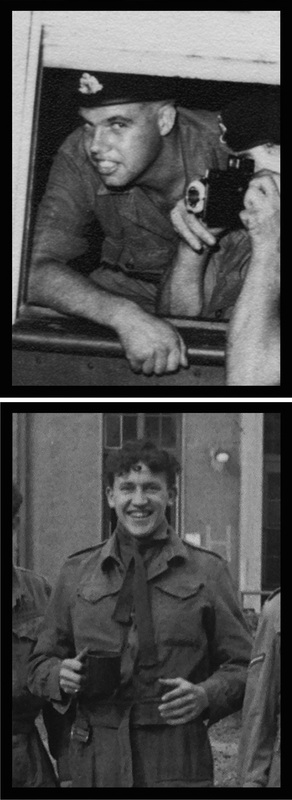
It is with much sadness that we have to report the passing of two national servicemen of the Suffolk Regiment.
Yesterday, came the sad news that George Flory, formerly of A Company of the 1st Battalion had passed away after a short illness. George was born in Ipswich in 1932, and was called up for National Service in 1951. After his basic training at Blenheim Camp, he was posted to Malaya to take part in active operations against the communist terrorists. After spells campaigning, George found a role as a clerk for A Company. His role was crucial in that under the command of Major O'Reilly, he distributed the Battalion and Company orders concerning patrols and typed up the 'after the battle' reports of the various engagements with the enemy.
George returned home from Malaya with the Battalion in January 1953 and was captured by a Reuters photographer leaning out of the train carriage as the Battalion left Kuala Lumpur. His mother saw the photograph in a newspaper at home in Ipswich and ordered a copy for the family album (above left).
George returned to civilian and trained as a bricklayer, building several of the new estates around Ipswich and the surrounding villages. He was an active member of Ipswich Branch of the Old Comrades Association and was a regular attendee at Minden Day until ill health prevented him attending. Georges life was sadly scarred with sadness. Having married twice, he lost both of his wives to illness. In consolation he took up watercolour classes at the Ipswich Institute becoming an accomplished and respected local artist.
George had recently had a fall which had worried him enough to decide to leave his home and go into sheltered accommodation. Our thoughts are with George's family at this time.
Then today, we heard the news that Chris Veness, also known as Chris Black, formerly of 1/Suffolk who had served in Cyprus between 1957 and 1959, had passed away after a prolific musical career.
Born in North London in 1938, Chris "Fender" Black was called up for National Service in 1957, serving for 18 months in Cyprus with 1/Suffolk. After a few weeks, he found himself posted to C Company, then on active operations in the city of Nicosia. Already an accomplished guitarist before he was called up, Chris played in a number of the Regimental skiffle groups that were formed in Cyprus. He founded "N.S. Six" (National Service Six) and played in other groups such as the "Kykko Kats" and the "Eastenders." Although Chris's time with 1/Suffolk had almost expired in the autumn of 1959, his draft was extended by six months, so that at when the Battalion went to Germany for amalgamation, it would be at half strength so that when they were merged with the 1/Royal Norfolk, the new Battalion would be at immediate full strength.
Chris was still an active Regimental musician in Germany where he was to star with his skiffle group on television. However, a week before they were due to appear, his service ended and he was sent home for demob.
The Suffolk Regiment was but a small part in Chris's life. Following his Army service, he became a professional musician playing with some of the leading artists of the 1960s and 1970s including Duane Eddy, Brain Poole, Johnny and the Hurricanes and the Walker Brothers. Chris however, rose to Internet stardom when he married his guitar, "Brenda the Fenda" in 2002, elevating him immediately to the rock hall of fame.
Chris only returned to the Regimental family in the last few years when the veterans of the Cyprus campaign started to meet up. A large than life character, he will be missed this year on Minden Day. Our thoughts are with his family and his old Cyprus pals at this difficult time.
(Posted: 19/02/2016)
Yesterday, came the sad news that George Flory, formerly of A Company of the 1st Battalion had passed away after a short illness. George was born in Ipswich in 1932, and was called up for National Service in 1951. After his basic training at Blenheim Camp, he was posted to Malaya to take part in active operations against the communist terrorists. After spells campaigning, George found a role as a clerk for A Company. His role was crucial in that under the command of Major O'Reilly, he distributed the Battalion and Company orders concerning patrols and typed up the 'after the battle' reports of the various engagements with the enemy.
George returned home from Malaya with the Battalion in January 1953 and was captured by a Reuters photographer leaning out of the train carriage as the Battalion left Kuala Lumpur. His mother saw the photograph in a newspaper at home in Ipswich and ordered a copy for the family album (above left).
George returned to civilian and trained as a bricklayer, building several of the new estates around Ipswich and the surrounding villages. He was an active member of Ipswich Branch of the Old Comrades Association and was a regular attendee at Minden Day until ill health prevented him attending. Georges life was sadly scarred with sadness. Having married twice, he lost both of his wives to illness. In consolation he took up watercolour classes at the Ipswich Institute becoming an accomplished and respected local artist.
George had recently had a fall which had worried him enough to decide to leave his home and go into sheltered accommodation. Our thoughts are with George's family at this time.
Then today, we heard the news that Chris Veness, also known as Chris Black, formerly of 1/Suffolk who had served in Cyprus between 1957 and 1959, had passed away after a prolific musical career.
Born in North London in 1938, Chris "Fender" Black was called up for National Service in 1957, serving for 18 months in Cyprus with 1/Suffolk. After a few weeks, he found himself posted to C Company, then on active operations in the city of Nicosia. Already an accomplished guitarist before he was called up, Chris played in a number of the Regimental skiffle groups that were formed in Cyprus. He founded "N.S. Six" (National Service Six) and played in other groups such as the "Kykko Kats" and the "Eastenders." Although Chris's time with 1/Suffolk had almost expired in the autumn of 1959, his draft was extended by six months, so that at when the Battalion went to Germany for amalgamation, it would be at half strength so that when they were merged with the 1/Royal Norfolk, the new Battalion would be at immediate full strength.
Chris was still an active Regimental musician in Germany where he was to star with his skiffle group on television. However, a week before they were due to appear, his service ended and he was sent home for demob.
The Suffolk Regiment was but a small part in Chris's life. Following his Army service, he became a professional musician playing with some of the leading artists of the 1960s and 1970s including Duane Eddy, Brain Poole, Johnny and the Hurricanes and the Walker Brothers. Chris however, rose to Internet stardom when he married his guitar, "Brenda the Fenda" in 2002, elevating him immediately to the rock hall of fame.
Chris only returned to the Regimental family in the last few years when the veterans of the Cyprus campaign started to meet up. A large than life character, he will be missed this year on Minden Day. Our thoughts are with his family and his old Cyprus pals at this difficult time.
(Posted: 19/02/2016)
A Grand Day Out
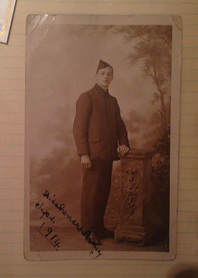
Today, the Friends attended the Suffolk Branch of the Western Front Association's 2016 seminar.
In an action packed day of eminent first world war academics and authors, the major battles and commanders of 1916 were discussed and debated. The team from Great War Huts were there to provide a fantastic display of allied uniforms including a mannequin displaying a tunic of a 2/Lieutenant of the Suffolk Regiment.
Perhaps the highlight of the day for us was however, the offering for sale by Tim Harper of World War Books, of a unique scrapbook belonging to an officer of 2nd Suffolk who served from 1916 until recent of the war. Described in detail was the attack by the Battalion on the 'Harp' in the opening phase of the Arras offensive in April 1917, and the Battalions actions at Paschendaele in July 1917.
Luckily it has been purchased by a friends member and hopefully, we'll see some of its amazing contents in future editions of our magazine.
(Posted: 13/02/2016)
In an action packed day of eminent first world war academics and authors, the major battles and commanders of 1916 were discussed and debated. The team from Great War Huts were there to provide a fantastic display of allied uniforms including a mannequin displaying a tunic of a 2/Lieutenant of the Suffolk Regiment.
Perhaps the highlight of the day for us was however, the offering for sale by Tim Harper of World War Books, of a unique scrapbook belonging to an officer of 2nd Suffolk who served from 1916 until recent of the war. Described in detail was the attack by the Battalion on the 'Harp' in the opening phase of the Arras offensive in April 1917, and the Battalions actions at Paschendaele in July 1917.
Luckily it has been purchased by a friends member and hopefully, we'll see some of its amazing contents in future editions of our magazine.
(Posted: 13/02/2016)
A Little Help To Our Chums In Gibraltar
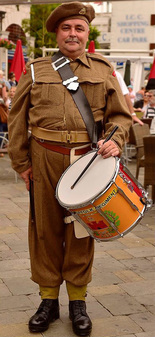
Last September, the Friends were contacted by Frank Coombes of the Gibraltar Re-enactment Society who every week re-enact the Ceremony of the Keys in period uniform.
The group which are usually dressed in uniforms of the 19th and 19th centuries, had recent acquired Second World War battledress and wanted to emblazon one of their drums in the style of the Suffolk Regiment from the 1939-1945 period. We explained that only the 31st Battalion were stationed at Gibraltar in 1945, but that we had no reference as the scheme of emblazon for this Battalion, we sent him the original artwork for the 1st Battalion with photographs of the Roubaix Drum (which is of the period) from the Regimental Museum Collection.
We were therefore delighted to be forwarded the photograph left, of one of the Society's Drummers, complete in Suffolk battledress, with a Regimental side drum. The central emblazon is an almost exact copy of the Roubaix drum with the Honour "Gibraltar 1779-1783" below the Battalion scroll and a red gibraltar castle surrounded by wreaths of oak and laurel, joined together at the base by the Roman numeral "XII"
His drum is rod tensioned and so far as we know, no rod tension drums were ever played by the Suffolk Regiment; they were all rope tensioned. There is a rod tensioned 4th Battalion Drum in the Regimental Museum, but this might be a conversion of an older rope-tensioned drum.
(Posted: 06/02/2016)
The group which are usually dressed in uniforms of the 19th and 19th centuries, had recent acquired Second World War battledress and wanted to emblazon one of their drums in the style of the Suffolk Regiment from the 1939-1945 period. We explained that only the 31st Battalion were stationed at Gibraltar in 1945, but that we had no reference as the scheme of emblazon for this Battalion, we sent him the original artwork for the 1st Battalion with photographs of the Roubaix Drum (which is of the period) from the Regimental Museum Collection.
We were therefore delighted to be forwarded the photograph left, of one of the Society's Drummers, complete in Suffolk battledress, with a Regimental side drum. The central emblazon is an almost exact copy of the Roubaix drum with the Honour "Gibraltar 1779-1783" below the Battalion scroll and a red gibraltar castle surrounded by wreaths of oak and laurel, joined together at the base by the Roman numeral "XII"
His drum is rod tensioned and so far as we know, no rod tension drums were ever played by the Suffolk Regiment; they were all rope tensioned. There is a rod tensioned 4th Battalion Drum in the Regimental Museum, but this might be a conversion of an older rope-tensioned drum.
(Posted: 06/02/2016)
Given Their Marching Orders
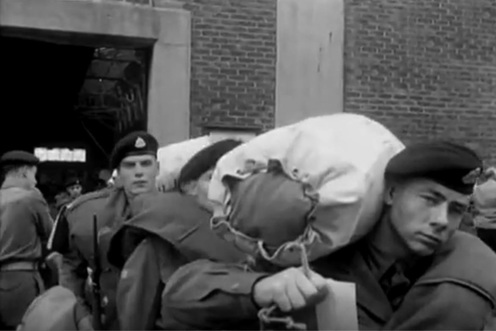
Today we received the rather sad news that the Leiston Branch of the Old Comrades Association will shortly be made homeless.
The Branch, which has met at the Leiston Town Athletic Association for over 25 years, has been forced to move on after the club received a new management.
The LTAA has been the venue for the successful parties that the Branch organises annually in December and May, which are instrumental in ensuring that the other than Minden Day, the surviving ranks of the Suffolk Regiment get together with their wives to re-live old times over a drink and a good tune.
Temporarily, the Branch will meet in a pub in the town, but with the move from the LTAA, it looks like the parties may now cease. Leiston Branch have been huge supporters of the Friends rights since its conception. We hope that they will soon be back up and running and functioning again like old times.
(Posted: 04/02/2016)
The Branch, which has met at the Leiston Town Athletic Association for over 25 years, has been forced to move on after the club received a new management.
The LTAA has been the venue for the successful parties that the Branch organises annually in December and May, which are instrumental in ensuring that the other than Minden Day, the surviving ranks of the Suffolk Regiment get together with their wives to re-live old times over a drink and a good tune.
Temporarily, the Branch will meet in a pub in the town, but with the move from the LTAA, it looks like the parties may now cease. Leiston Branch have been huge supporters of the Friends rights since its conception. We hope that they will soon be back up and running and functioning again like old times.
(Posted: 04/02/2016)
Strike Up The Band
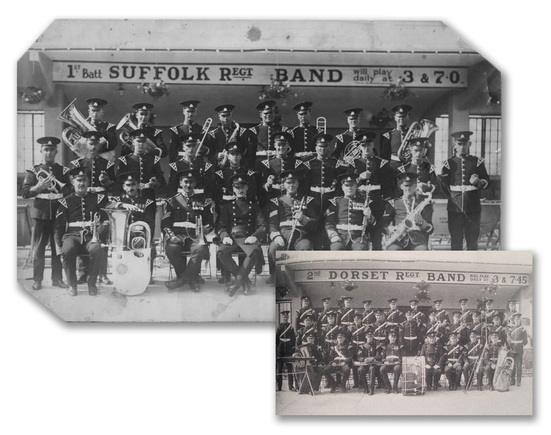
About five years ago, we spotted this photograph on the Internet. It showed the Band of the 1st Battalion taken it said, in India in the 1930s. We were a little confused as the backdrop didn't look particularly Indian; in fact it looked rather like a traditional deco lido or pavilion somewhere in the UK, but the chances of finding where it could be seemed impossible and in all probability, it was long since demolished to make way for Tesco's or something similar.
Then this morning, whilst leafing through a second-hand bookshop, we came across a copy of the excellent "The Dorsetshire Regiment" by Terry Bishop, which showed a near identical picture of the Band of the 1st Dorset's taken at the Hurne Bay Bandstand in Kent in 1929.
Finally, we'd found the location and a quick look at Google earth confirms that it still survives. All we now have to find out is when it was taken....any ideas?
(Posted:23/01/2016)
Then this morning, whilst leafing through a second-hand bookshop, we came across a copy of the excellent "The Dorsetshire Regiment" by Terry Bishop, which showed a near identical picture of the Band of the 1st Dorset's taken at the Hurne Bay Bandstand in Kent in 1929.
Finally, we'd found the location and a quick look at Google earth confirms that it still survives. All we now have to find out is when it was taken....any ideas?
(Posted:23/01/2016)
Keeping Warm In The Cold Snap
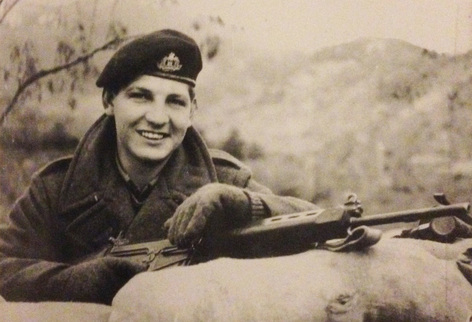
In these cold dark winter days, make sure you all keep wrapped up warm. The excuse to don scarves, balaclavas and heavy coats reminded us of one of the last photographs taken of the Suffolk Regiment on active service.
The photograph left, shows Private Bassett keeping lookout from his sandbagged 'sangar' high up in the Troudos mountains on Cyprus. The thick woollen double-breasted greatcoat and gloves were ideal for long periods of standing on guard, but were awkward if one had to give chase!
Bassett shows the Cyprus trademark of wearing his badge in the centre of his beret, rather than over his right eye - if the Sergeant-Major caught him, he's incur such language from him that would "make a Bishop kick a hole in a stained glass window!"
(Posted: 21/01/2016)
The photograph left, shows Private Bassett keeping lookout from his sandbagged 'sangar' high up in the Troudos mountains on Cyprus. The thick woollen double-breasted greatcoat and gloves were ideal for long periods of standing on guard, but were awkward if one had to give chase!
Bassett shows the Cyprus trademark of wearing his badge in the centre of his beret, rather than over his right eye - if the Sergeant-Major caught him, he's incur such language from him that would "make a Bishop kick a hole in a stained glass window!"
(Posted: 21/01/2016)
Happy New Year!
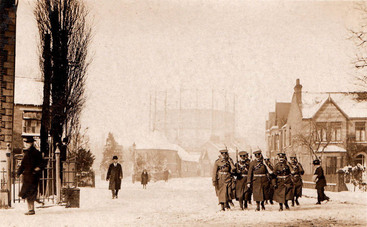
A very happy New Year to all Friends.
We hope that 2016 brings you much joy and happiness. The Friends are looking forward to another action packed year. Our summer battlefield tour is full and people are rapidly coming in to fill up our proposed tour to Holland in September.
We will shortly be publishing our 20th magazine in March reaching a milestone we though we'd never achieve, and membership is on the up - but we still need many more members to ensure that the Suffolk Regiment is never forgotten.
(Posted: 01/01/2016)
We hope that 2016 brings you much joy and happiness. The Friends are looking forward to another action packed year. Our summer battlefield tour is full and people are rapidly coming in to fill up our proposed tour to Holland in September.
We will shortly be publishing our 20th magazine in March reaching a milestone we though we'd never achieve, and membership is on the up - but we still need many more members to ensure that the Suffolk Regiment is never forgotten.
(Posted: 01/01/2016)
Top: Major Stokoe, Captain Sperling and Lieutenant Perrett, chuckle from the touchlines of a 1/Suffolk football match in Palestine, 1945.
